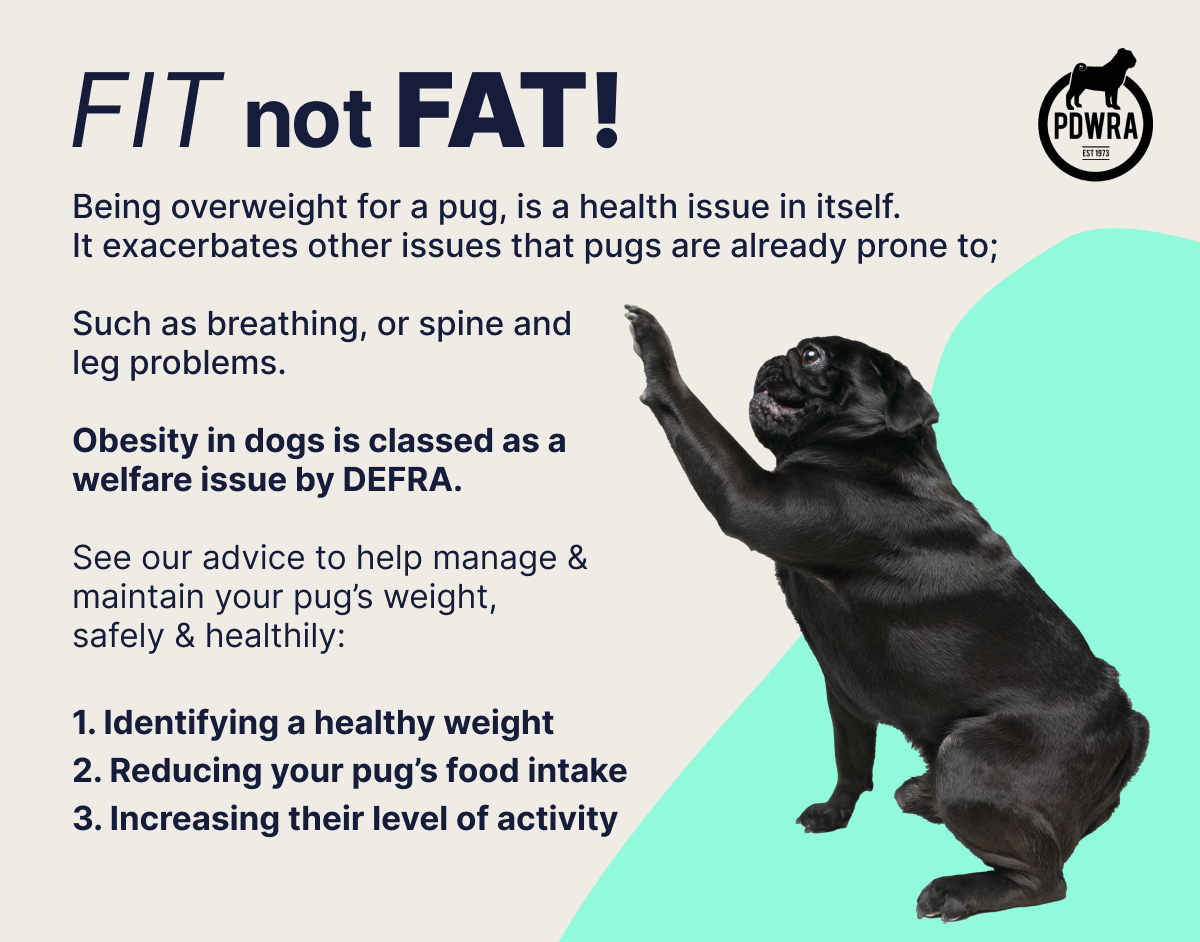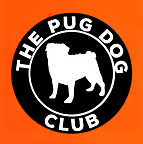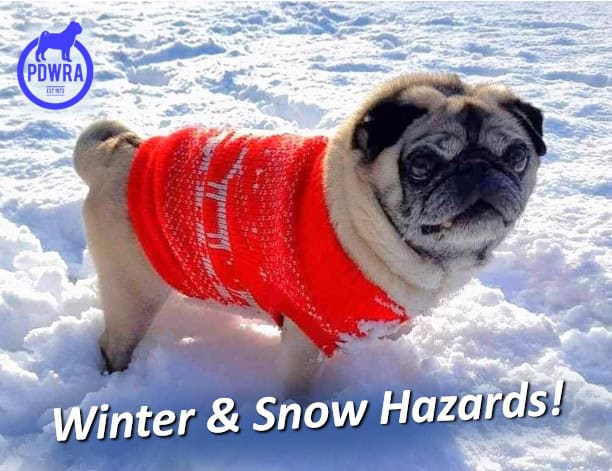
by Yasmin | 19 Nov, 2025 | Blog, Pug Health
Temperatures are dropping and after unusually warm temperatures for November, snow is scattering around the country!
So, here are our regular tips and advice to help your pug brave the cold, safely, to remain happy during the wet & cold months, ensuring it remains a fun and enjoyable time with your best friend!
– Beware of salt on roads & paths which can burn their paw pads.
Check once home and rinse them if necessary.
– Ice and snow can stick to the fur between pads and build up. This will be uncomfortable for your pug and increases their risk of frostbite.
If they raise their paws, stop walking or whine it could be a sign that their paws are too cold.
– Also, beware of thin ice & frozen puddles.
– Take care when using antifreeze. It tastes sweet so is tempting for dogs but can be lethal if ingested.
– Watch for dogs drinking out of puddles too as they may be tainted with antifreeze chemicals from spills or leaks.
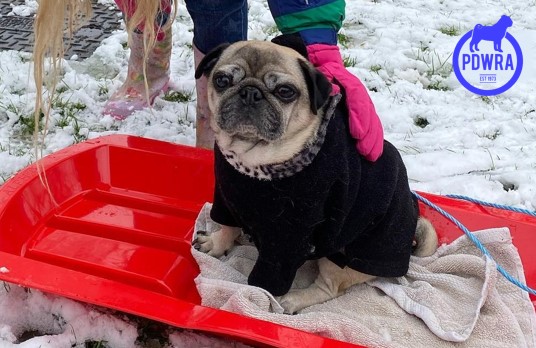
– When cold, a dog’s body will limit blood flow to their extremities (paws, tail, ears etc.), in order to keep their vital organs functioning safely.
This can put their extremities at risk of being damaged by the cold.
– It’s a good idea to get a warm coat for them, essential when it’s very cold but still safe to go outdoors. See temperature chart below.
Ensure it fits well & is flexible so that it doesn’t prevent them moving normally, either by being too tight or too loose.
– If your dog starts shivering, or appears very tired (lethargic), then get them home as soon as possible.
If they continue to seem unwell, contact your vet immediately.
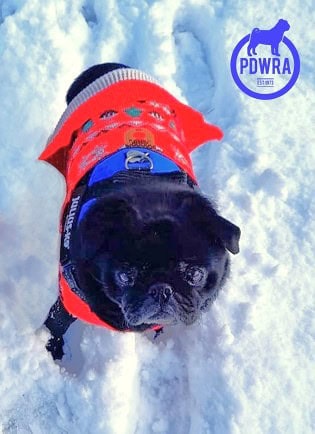
Here are some Body-care tips:
– Additional to well-fitting warm outerwear, use paw protection if needed, this could be in the form of dog dry skin creams/ balms, or doggy booties.
– Inspect pug paws regularly to check for cracked pads, broken nails or snow/salt damage.
– Brush your pug’s coat regularly to distribute natural oils to the skin and prevent dry patches.
– If it’s windy, don’t forget to protect their eyes, by extra lubrication gels and especially if on a beach, where wind & sand can scratch them causing lasting damage without urgent treatment.

Please check this very useful guide to see if it’s wise to take your pugs out! :
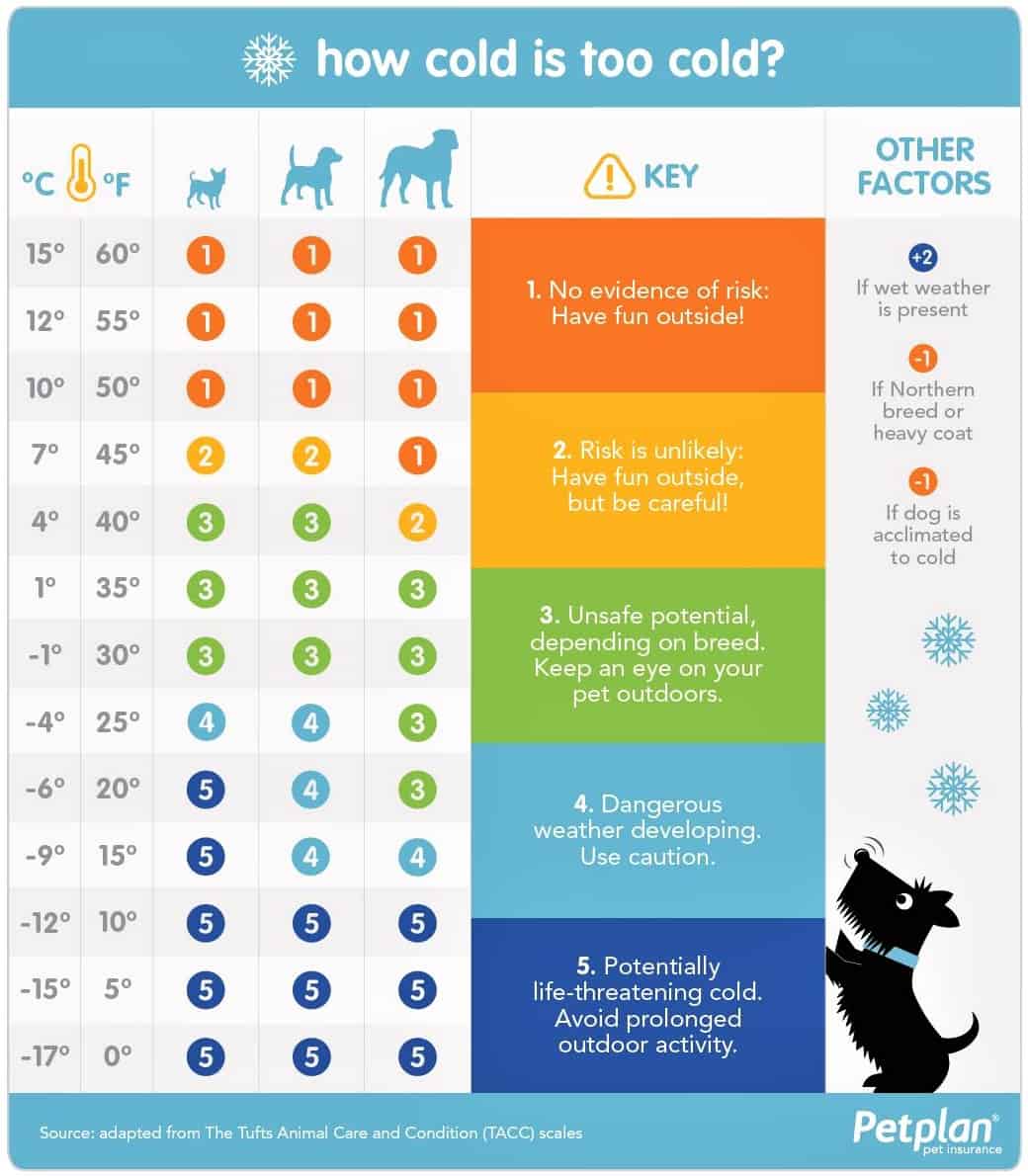
If your pug shows signs of hypothermia, which includes, shivering, drowsiness, confusion, clumsiness, pale gums and loss of consciousness or collapse, get your pet immediately out of the cold & contact your vet straight away.
Dry & warm them up gently, never intensely & too quickly as this can be dangerous.
For further information, please see:
Hypothermia in Pets – PDSA
Also,
Keep your dog safe during winter | The Kennel Club
Have fun while staying safe!
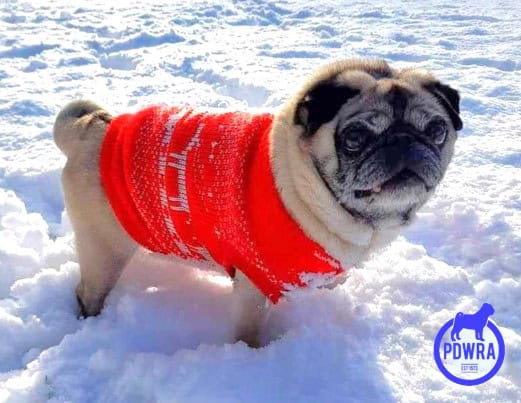
******
And for our Seasonal Hazard webpage, please go to:
Seasonal Hazards for Pugs | The Pug Dog Welfare & Rescue Association (pugwelfare-rescue.org.uk)
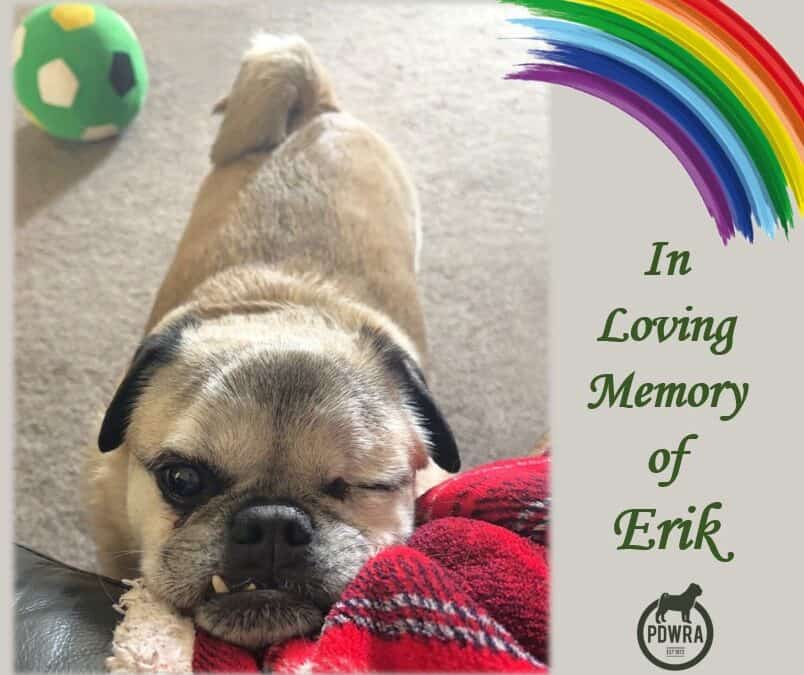
by Yasmin | 29 Oct, 2025 | Blog, In Memoriam
For Erik, Our Pudding!
“I’ll never forget the day I met my little pudding, Erik. A cold night in January of 2015, my parents and I were visiting my grandparents when late into the evening my mam got a phone call – she just had to leave for something, and I couldn’t know why.
Half an hour later she walks up to the back door with a rather podgy thing following behind her. I couldn’t believe it, my very own pug after many years of being told ‘no you’re not getting one’. That night he curled up into a little ball on my bed, finally he was in a safe and loving home.
I could sit all day and talk about all the funny stories we have of our little piggy, but nothing I say feels like it does the justice of describing his quirky little character – for a small thing, he had a huge personality. Instead, I’ve written a poem, and I would say it’s for him but rather selfishly I feel it may be more for me!
So, here’s to you Puddin’…
Travelling in a Taxi alone,
A life of abuse and hurt was all you had known.
Until you came to live with us,
You were always barking, always making a fuss.
But we loved you and your grumble,
Your soft snore, your playful mumble.
Mam’s little Prince,
Life hasn’t been the same since.
For the last time we packed away Lambsy and your lead,
Come back now Puds I plead.
Your goofy teeth that looked like a smile,
Made every moment more worthwhile.
Seeing your tail wag,
Each day felt brighter, like less of a drag.
Dad’s Piggy Wiggy Woo,
We miss you.
That little twinkle in your eye,
The hardest goodbye.
My best boy, my confidant,
A breath so stinky strangers would recant.
From primary school to university,
You brought love and vitality.
My gorgeous Puds,
My tears flow for you in floods.
Through all the days and all the time,
Until we meet again the memories of you will shine.
We love you so much,
The things I would do for one last ‘Cwtch’.
Sleep well our boy,
Our bond is something you cannot destroy.
Our little Pig,
The hole you have left is oh so big.
I’ll never forget the day I met my little pudding, Erik.”
Love from all of us. xxx

by Yasmin | 29 Oct, 2025 | Pug Home Appeal, Blog, News, Rescue Stories
ALBERT’s APPEAL is CLOSED.
Sincere THANKS to ALL his enthusiastic Adoption Applicants.
Within weeks, Albert is well-settled in his loving Forever Home.
*********
OCT 8th : ORIGINAL APPEAL INFORMATION for ALBERT.
Five-year-old Albert is a placid and easy-going boy. He is neutered, and has lived a very sheltered, apartment-based life with elderly owners, and as a result, can be shy and reserved.
Albert is living with other dogs for the first time in his foster home and has settled in well. It took him about 10 days to relax with them. He can still be wary, and will avoid them if the games get a bit rough. He will always back down when loose in the garden playing with them.
.
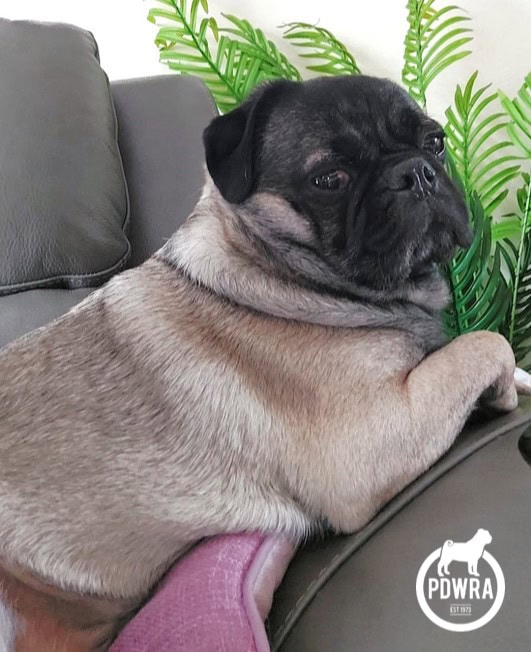
Albert is wary of strangers. He doesn’t mind seeing people or dogs when out and about but prefers to be ignored by them. On the lead, he’ll pass by other dogs quietly if given a wide berth.
He loves his walks and can be strong on the lead if there is a lamp-post or litter bin to be sniffed at but you aren’t getting there quickly enough for him!
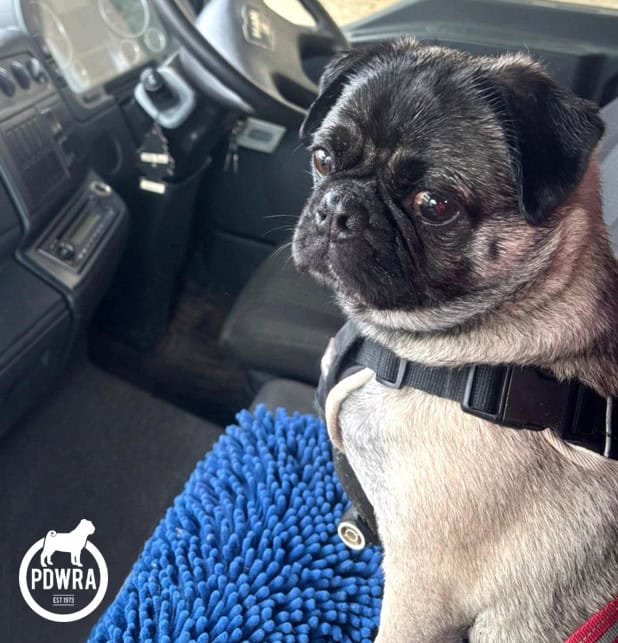
Albert will bark at strangers entering the home, but not aggressively. This is an area that will require patience and further work in his new home but should improve with confident guidance.
We feel that he would benefit from the company of a calm, confident dog for reassurance and companionship.
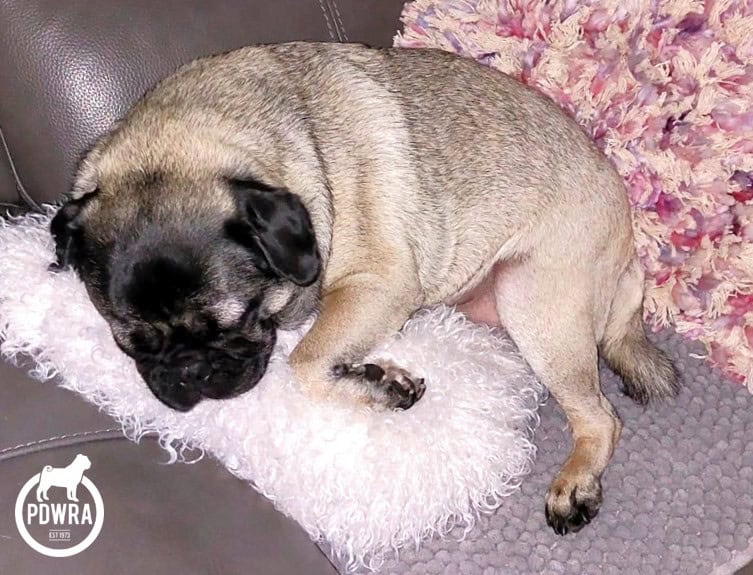
Albert enjoys a cuddle and being stroked or gentle play. He has reasonable recall in the home environment and will sit, give a paw and pop in his crate when it’s bedtime.
Here, however, you can see his playful side is starting to come out now, which is great progress really lovely to see!
******
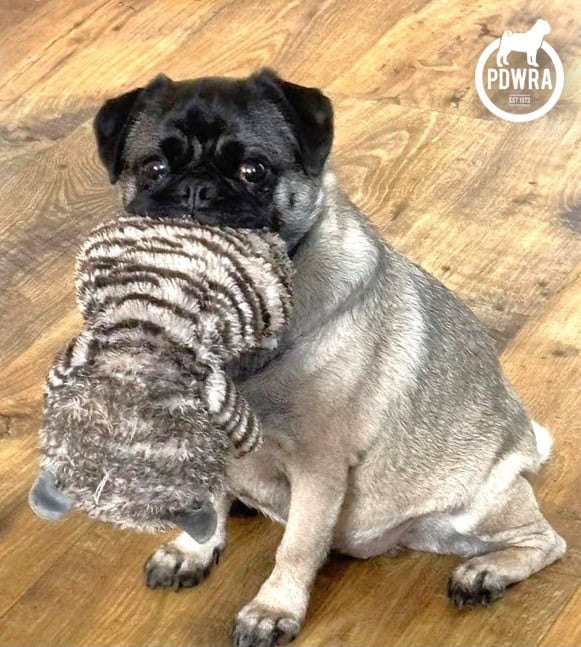
Albert may be best suited to an adult-only home or one with calm, older children. He hasn’t been tested regarding cats.
It’s important to also read our Guidelines & conditions for Adopting, at:
https://pugwelfare-rescue.org.uk/adopting-a-pug/
We are currently on HOLD to new applications, due to a terrific response for Adorable Albert.
If you have any specific questions about him or your application, please email Cara at:
sw@nullpugwelfare-rescue.org.uk
******
To see a sample of other happy, successful, Rescue & Adoption Stories, please go to:
https://pugwelfare-rescue.org.uk/category/rescue-stories/
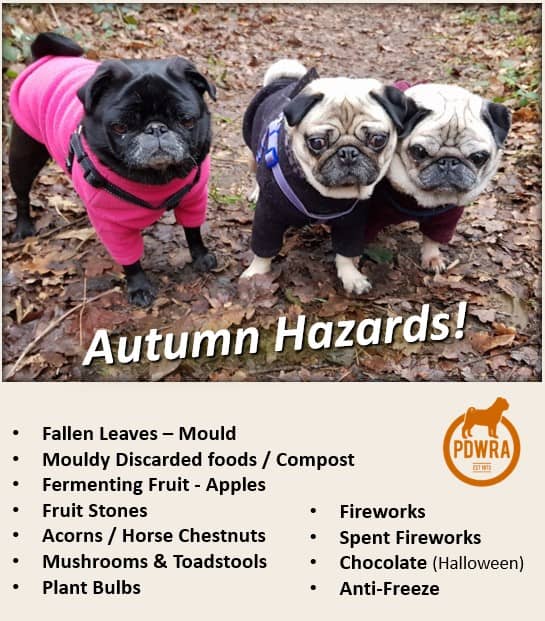
by Yasmin | 22 Oct, 2025 | Blog, Pug Health
As Autumn draws in, it’s a good idea to remind ourselves of the potential hazards to keep an eye out for, some quite serious, in order to keep our pugs safe particularly outdoors.
-
- Not only do piles of leaves hide what’s beneath them, they can develop bacteria and mould. If your dog ingests these it can lead to gastrointestinal upset.
- Likewise, mouldy discarded foods can contain lots of different toxins, in particular on dairy products, bread or nuts, which can cause dogs to quickly develop muscle tremors or seizures.
- Fermenting fruit, produces a natural alcoholic compound, which is toxic. If your dog eats such fruit, they are likely to suffer from sickness and diarrhoea, and also, may run the risk of having a toxic reaction to the natural alcohol produced by the fruit as part of its fermentation process.
- Fruit stones, cherries, damsons, plumbs or similar if chewed produce cyanide, if swallowed whole, can cause choking or obstruction.
- Acorns or horse-chestnuts (conkers) can lead to sickness and diarrhoea, and if ingested in large quantities are toxic. They are also a choke hazard or can potentially become lodged in the gut causing a blockage, so make sure that your dog doesn’t eat any!
- Dangerous mushrooms can be hard to identify, where signs of poisoning vary dramatically from stomach upset or blood in the stools to neurological effects such as hallucinations or fits, kidney or liver failure. The symptoms may present very suddenly or be delayed by days.
- Poisoning from spring bulbs like daffodils, tulips or crocus are most likely to occur from being eaten in autumn when they are planted, or when they begin to flower in spring.

It won’t be too long before we should be considering these too!
- Fireworks can contain hazardous chemicals which can be poisonous to your dog. Initially these poisons can cause vomiting, diarrhoea, tummy pain and/or bloody stools.
- More severe effects may include seizures and the chemicals may also affect your dog’s breathing, kidneys and liver.
- Don’t let your dog into your garden unsupervised around Bonfire Night and other seasonal celebrations, without checking first that none have fallen into your garden.
- Chocolate sales rise around Halloween, but remember it contains a stimulant called theobromine, poisonous to dogs.
- The amount of theobromine differs depending on the type of chocolate, dark chocolate having the most in it. Theobromine mainly affects the heart, central nervous system and kidneys.
- Signs can occur from 4 to 24 hours following ingestion where you may see vomiting, diarrhoea, restlessness, hyperactivity, rapid breathing, muscle tension, lack of coordination, increased heart rate and possibly seizure.
- Antifreeze, (ethylene glycol) is the worst of all the chemical spills, which can also leak from a car’s radiator.
- Ingestion is very dangerous. It is sweet tasting and very palatable to dogs, though even a relatively small quantity can cause serious kidney damage or be fatal.
- The first signs of intoxication can be that your dog appears ‘drunk’. If you know your dog has ingested ethylene glycol or you have any concerns, contact your vet without delay.
- The prognosis is poorer the longer it takes to initiate treatment.
So please be extra vigilant, and if you suspect your dog has been affected in any way. Contact your vet as soon as possible to discuss symptoms.
For further related information, see:
PDSA:
https://www.pdsa.org.uk/what-we-do/blog/caring-for-your-pet-in-autumn
&
https://www.pdsa.org.uk/what-we-do/blog/vet-qa-how-do-i-keep-my-pet-safe-from-de-icing-products?
The Kennel Club:
https://www.thekennelclub.org.uk/health-and-dog-care/health/health-and-care/a-z-of-health-and-care-issues/poisons-in-your-garden/
&
https://www.thekennelclub.org.uk/health-and-dog-care/health/health-and-care/a-z-of-health-and-care-issues/acorns/
Dogs Trust:
https://www.dogstrust.org.uk/dog-advice/health-wellbeing/at-home/poisonous-to-your-dog
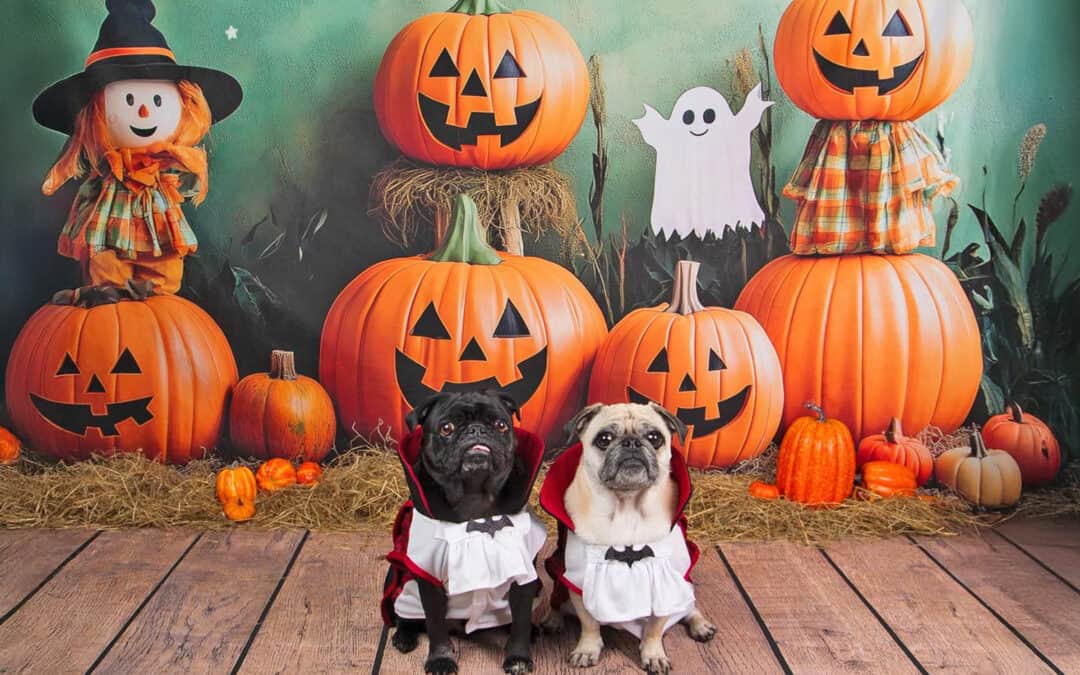
by Developer | 21 Oct, 2025 | Blog, News
Halloween is almost upon us once again and to celebrate, we bring you a wonderful selection of pugs getting into the spirit of the season!
Last week we did a competition on our Facebook page asking our followers to send in pictures of their pugs. We expected maybe 30 or 40 pictures but actually got thousands! There were several Halloween pictures thrown in, so we thought what better time to share them with you?!
In the header image are Bentley & Stanley in their best dressing up outfits, and we have a brilliant Halloween selection below…
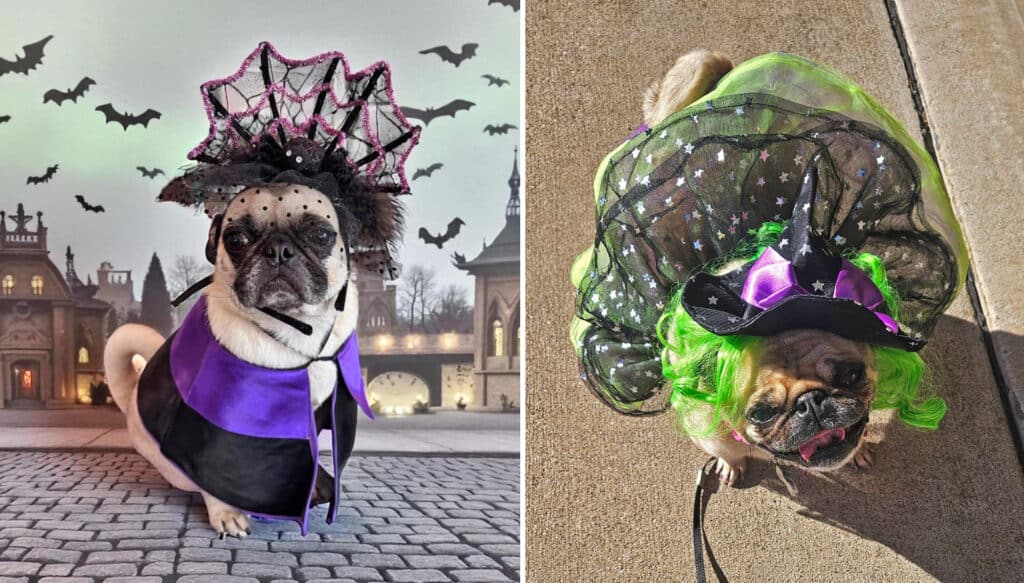
Marti & Zoey
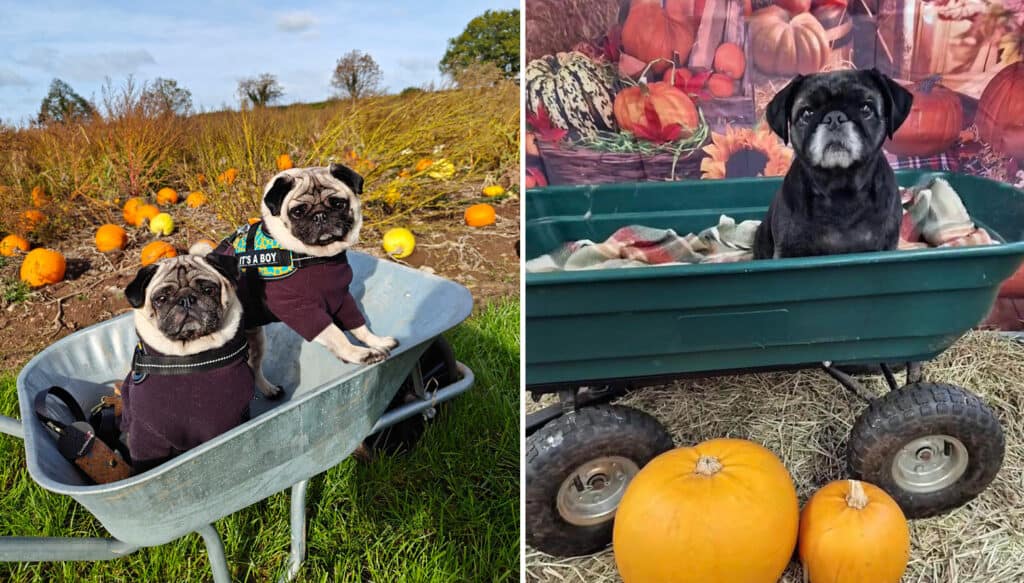
Hardy, Rufus & Coco
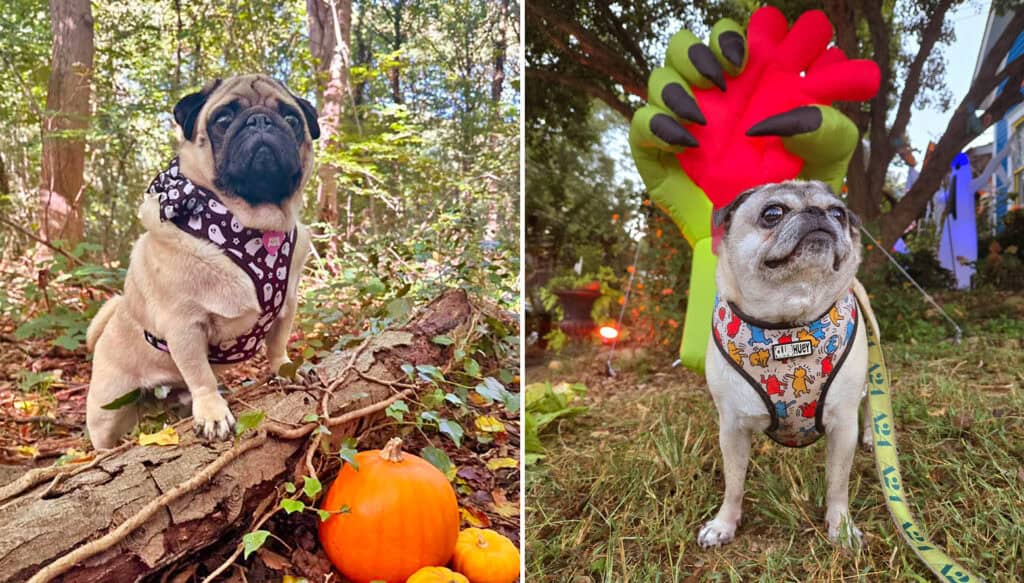
Petey & Pris
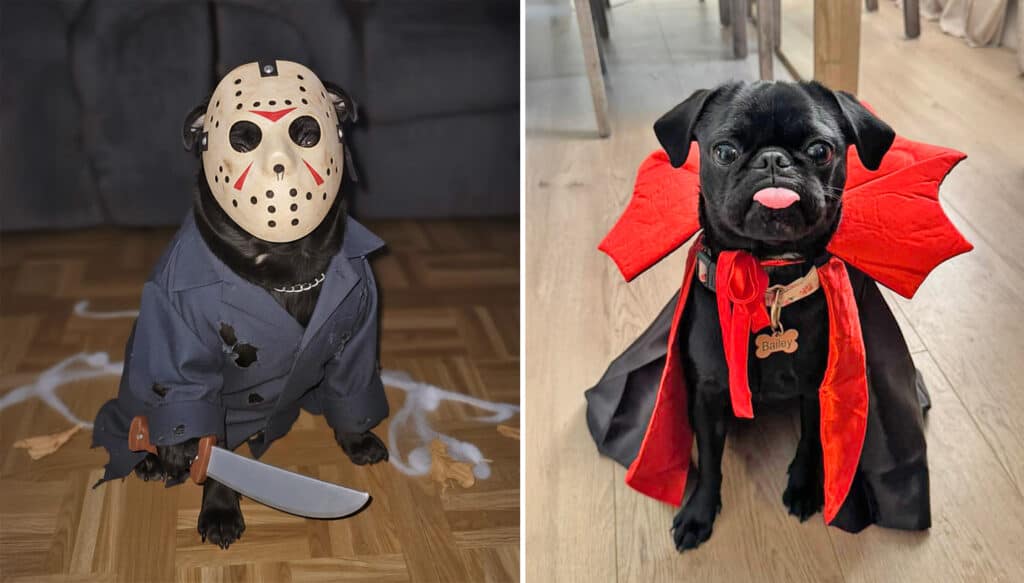
Puma & Bailey
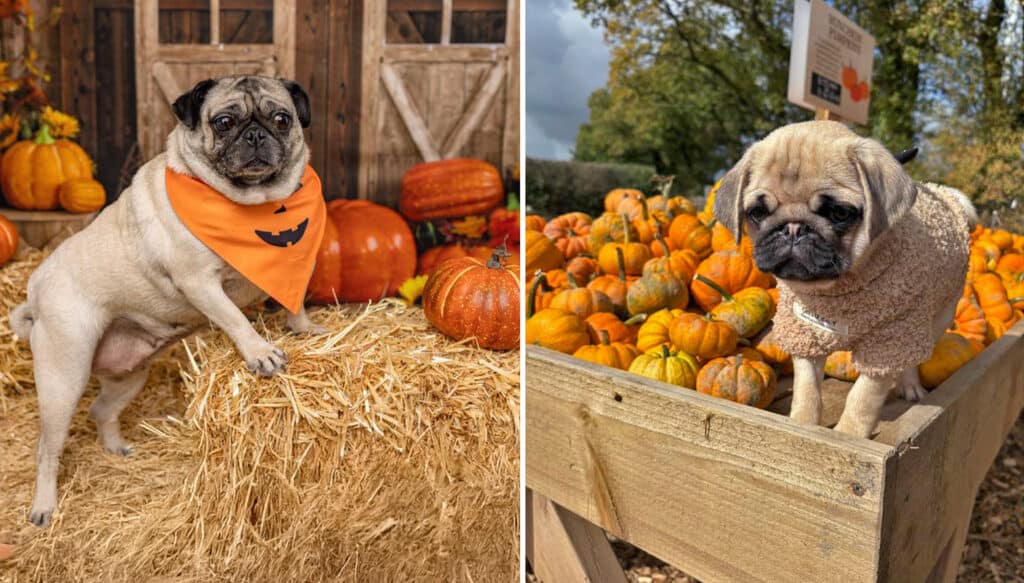
Rosie & Nacho
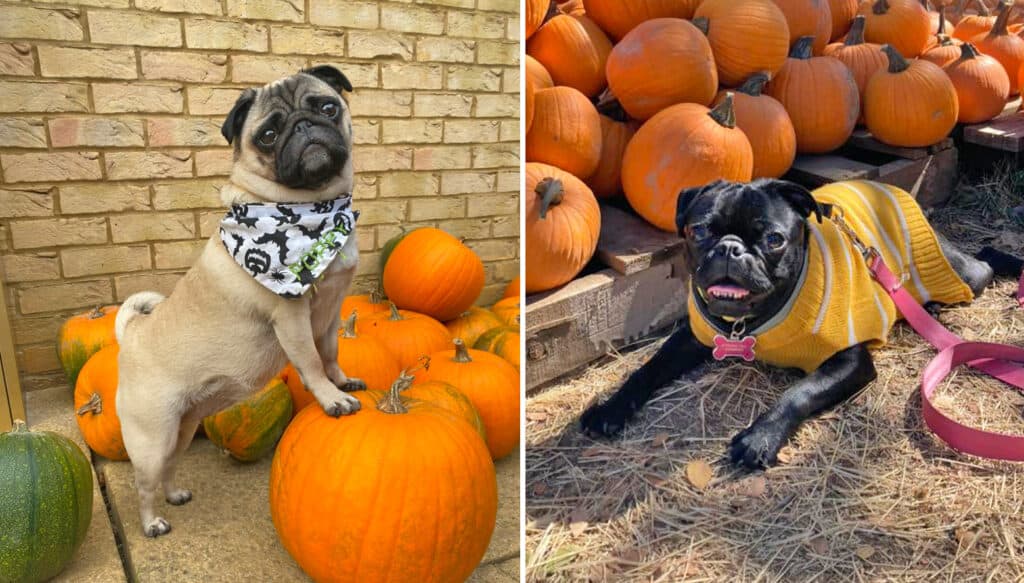
Poppy & Benny
If you’d like to follow us on Facebook and have the chance to enter more of our competitions, just click the link to head over to our page!
https://www.facebook.com/PDWRA

by Developer | 21 Oct, 2025 | Blog, Volunteering
For many devoted dog lovers, the chance to help a vulnerable animal is a calling that cannot be ignored. That rang true for me when I first discovered the Pug Dog Welfare & Rescue Association (PDWRA) via Facebook and have since become a part of the charity’s transport network.
After finding the PDWRA web page and learning that transport volunteers were needed, I didn’t hesitate to sign up. I wanted to help where I could with the support and welfare of pugs. Now, just over a year into my volunteering journey, I play a role in collecting pugs, often directly from their surrendering families, and safely delivering them to the next stage of their new lives.
The distances travelled vary but typically involve a 50–100-mile round trip from home, but I am always ready to cover “almost any distance” needed. I used to drive a lot for work and I’m very comfortable with driving long distances, I just take a lot more breaks when I have pugs on board! The journeys can be very emotional, especially when saying goodbye to former owners, but the reward is immense. Knowing that I am helping to give a pug or pugs a new life with better prospects, is what makes the effort worthwhile.
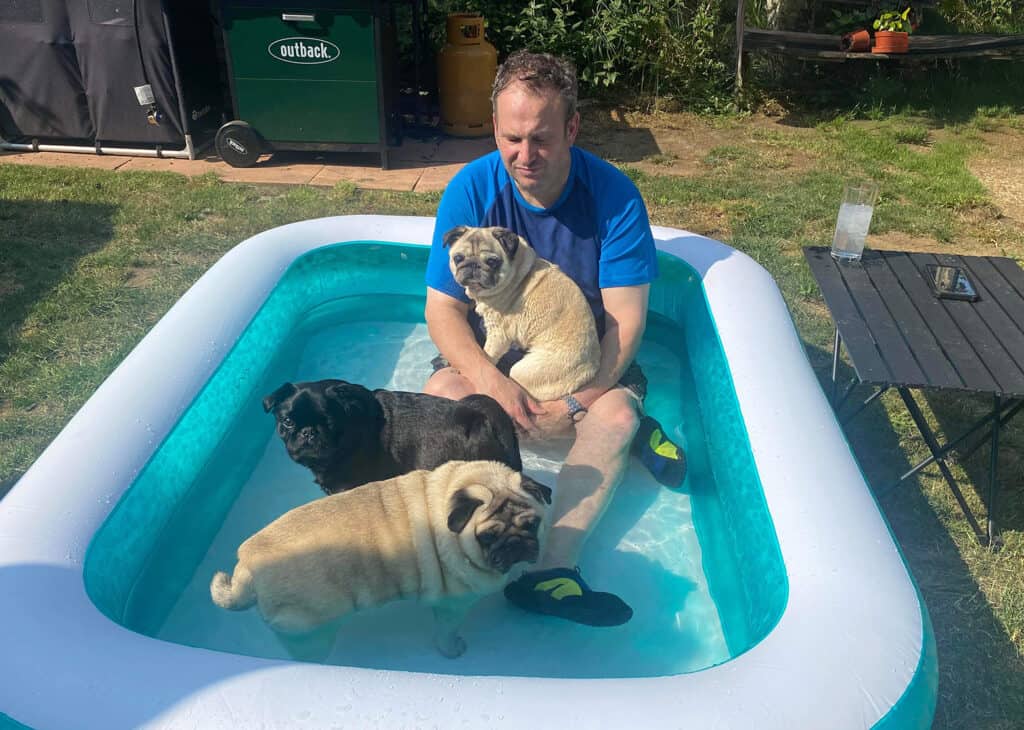
For prospective transporters, I recommend always carrying a spare lead and harness, plus plenty of water for breaks – especially if you’re bringing your own pugs along for the ride. I have three pugs of my own currently: two are from the PDWRA; one was adopted, and I offered another one a home as a long-term foster.
From heartfelt goodbyes to the joy of new beginnings, I like to think I embody the spirit of the PDWRA. One person can make such a difference, simply by answering the call to help, one pug at a time.
Brian
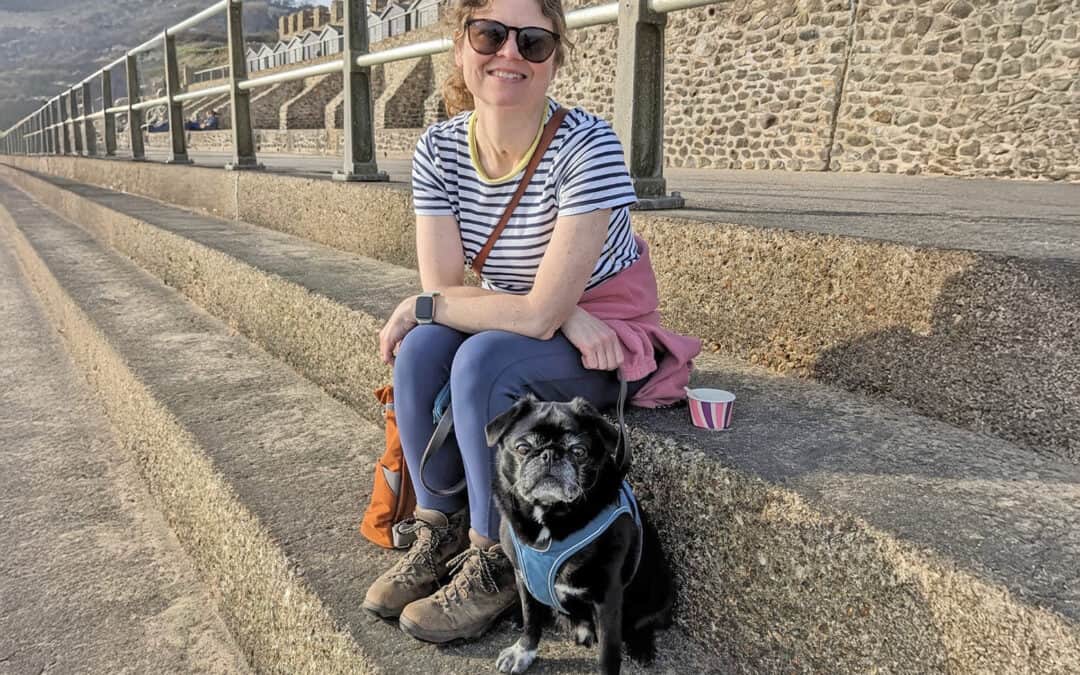
by Developer | 21 Oct, 2025 | Blog, Rescue Stories
In January 2024 we had to say goodbye to our beautiful elderly pug, Jack. I was heartbroken and missed him so much. We had been through so much together during his lifetime and it was hard to think of life without him.
After a couple of months or so, I started to have a tentative look for any pugs that might be in need a new home. I desperately missed Jack, and although it was difficult to imagine getting another dog, I knew I wanted another dog in my life. Whilst I love all dogs, I have a special soft spot for pugs, so I started to keep an eye on any needing new homes. I saw several, but none that felt quite right for us.
Then I saw a post about Stitch pop up in the PDWRA Facebook page and I knew instantly that he was the one! As soon as I saw his adorable, cheeky face and read about him I fell in love and knew we could give him what he needed. I contacted PDWRA immediately to say that we were interested and filled out an adoption application. After chatting with Stitch’s foster mum and passing the home check, we were delighted to be told that we could adopt Stitch!
He settled in very quickly and on the first night was more than happy to settle down in his bed in the kitchen for the night. The next day I took him for a walk over the fields around our village and found out very quickly that he very much enjoys rolling in stinky mud!
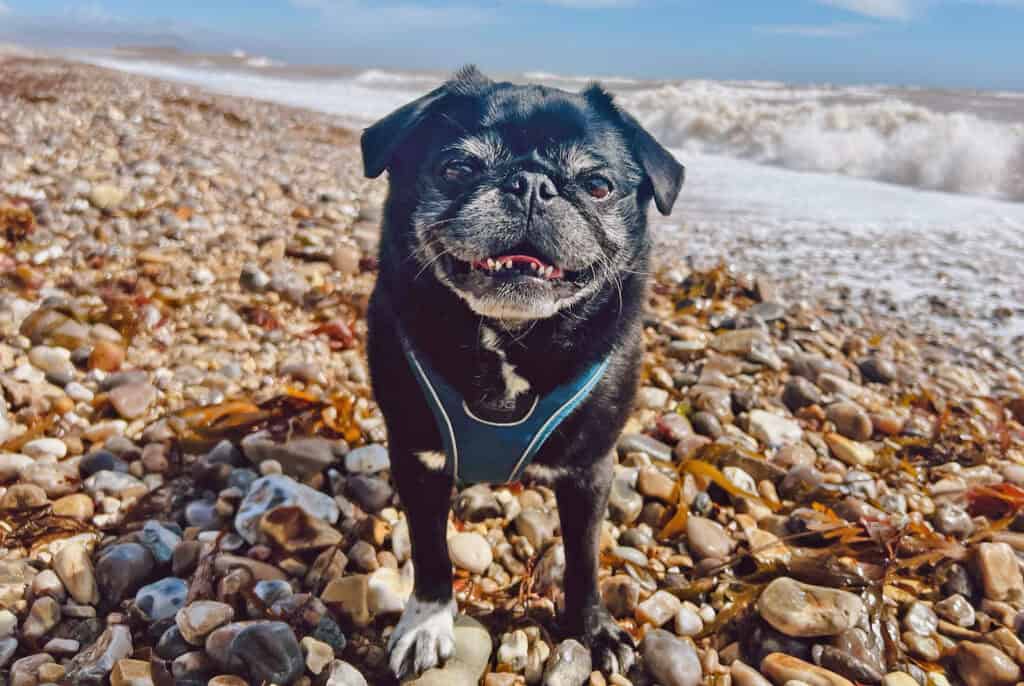
Over the next weeks and months, we enjoyed getting to know Stitch more and more. He is a delightful, chilled boy who loves walks, loves to play and learn but equally is happy to spend time relaxing at home having belly rubs.
Stitch can be reactive with some dogs when we are on walks, particularly when he is on the lead, so this is something that we have worked on with the help of a lovely local dog trainer. He enjoys meeting small dogs when we are out and about but tends to need space when he sees bigger dogs. Consistent training with this issue has resulted in him getting a lot less stressed about other dogs though and I am so proud of how far he has come over the last year.
He has also been going to a socialisation group once a week that is run by our dog trainer and has made brilliant progress with this as well. He was initially a little grumpy with the other dogs in the group (who all happen to be labradors) and would tell them off at the start of the session and then ignore them for the rest of it. But he has now reached the point where after a few weeks off from the group recently he was happy and excited to see his labradors friends again, which is such a massive difference!
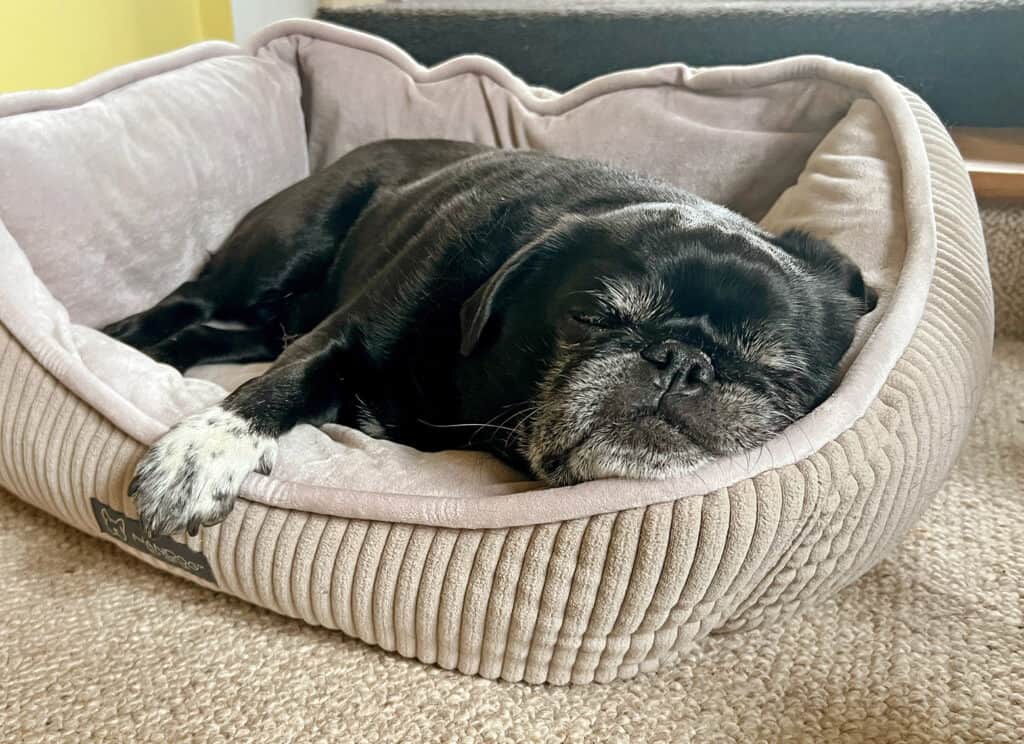
Stitch really has made the best little companion. I work from home and he is such an easy-going little pug to have by my side. We have a lovely walk through the village and across the fields in the morning. We do the same in the afternoon and pop out at lunchtime. I try to incorporate little bits if training into our walks and Stitch loves foraging for treats.
We’re around 45 minutes from the coast, so we try to take him there regularly for a run on the beach and a walk along the coastal paths.
We’ve had several holidays away with family since we got Stitch and he’s loved it because he loves going for walks and exploring new places. In June this year we had a week in Cornwall and Stitch loved exploring the beaches and rock pools. We did plenty of coast walks and Stitch managed a 6-mile hike one day! He certainly slept well that night!
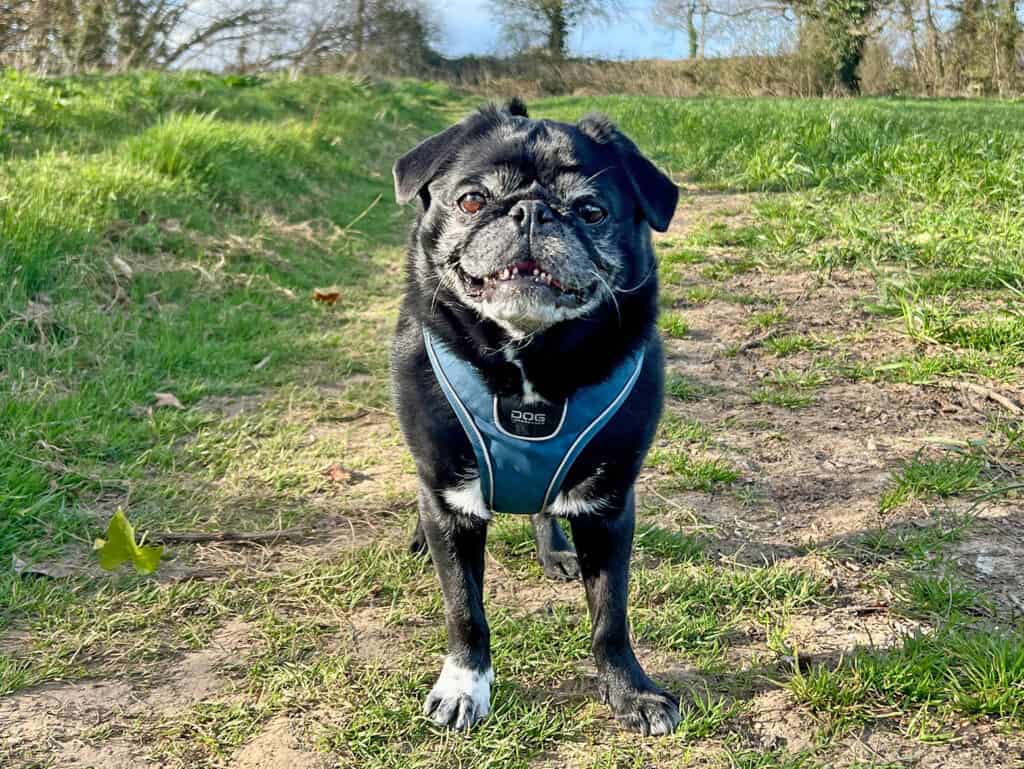
We have noticed that everyone who meets Stitch quickly becomes very taken with him (and they always love his white paw!) and I’ve had several people tell me they could quite happily take him home!
We now can’t imagine life without our lovely Stitchy! We absolutely adore him and it’s been such a pleasure to see how he has settled in with us over the last year.
I am so glad that we were there to offer him the fresh start that he needed.
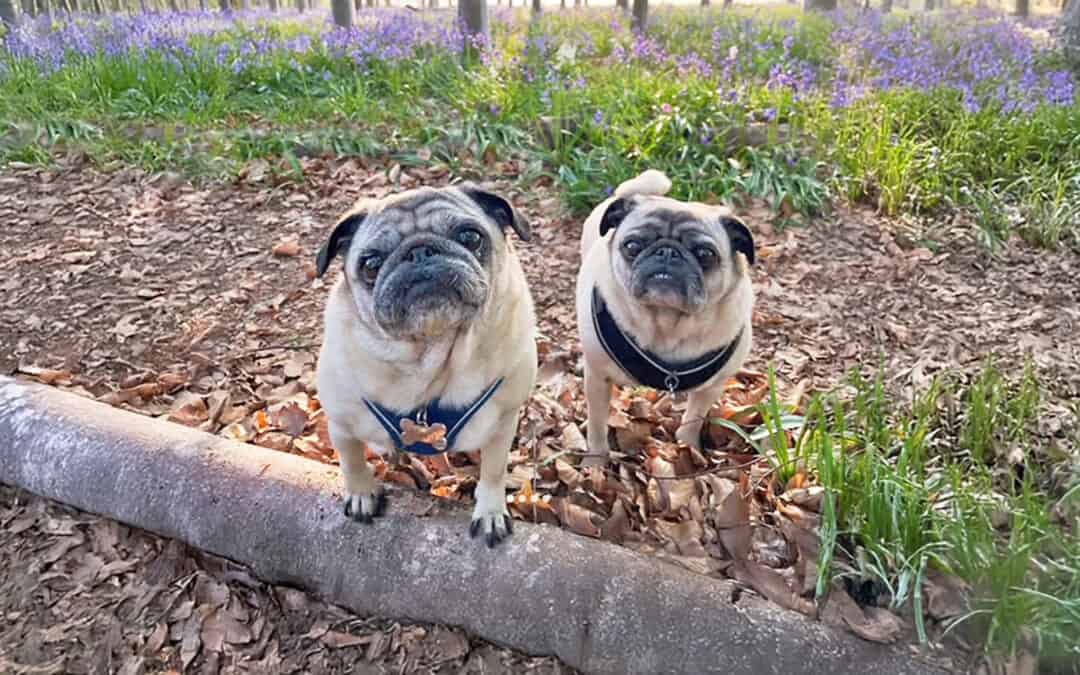
by Developer | 21 Oct, 2025 | Blog, Rescue Stories
Pugs have been part of my life all my life- my parents had a pug before they had me! But until Arlo and Nora came along, I had never adopted a pug.
I first heard of PDWRA a few years ago. I saw an appeal to save stamps and ink cartridges. I decided that I would try to help and friends and family were roped in. Aside from that I also make cards and illustrations as Onelittlepug, and I began fundraising by donating a portion of my sales to PDWRA.
Our beloved Pug, Henry, was not a rescue pug, but by the time he passed away in October 2023 at the grand old age of 15, I was convinced that if I was to have another pug it would be a rescue. I’d read so much from PDWRA about their work and was shocked at the number of pugs being surrendered.
So, I registered and indicated that I was prepared to consider a bonded pair or an older pug as I know that these are harder to re-home. After a home check and a chat with Jane, one of the Area Coordinators, it wasn’t long before I got a call. It was from Jackie, another Area Coordinator, and she said ‘I may have found you a pug……or two, I’ll send you a photo’- of course as soon as I saw the photo that was it!
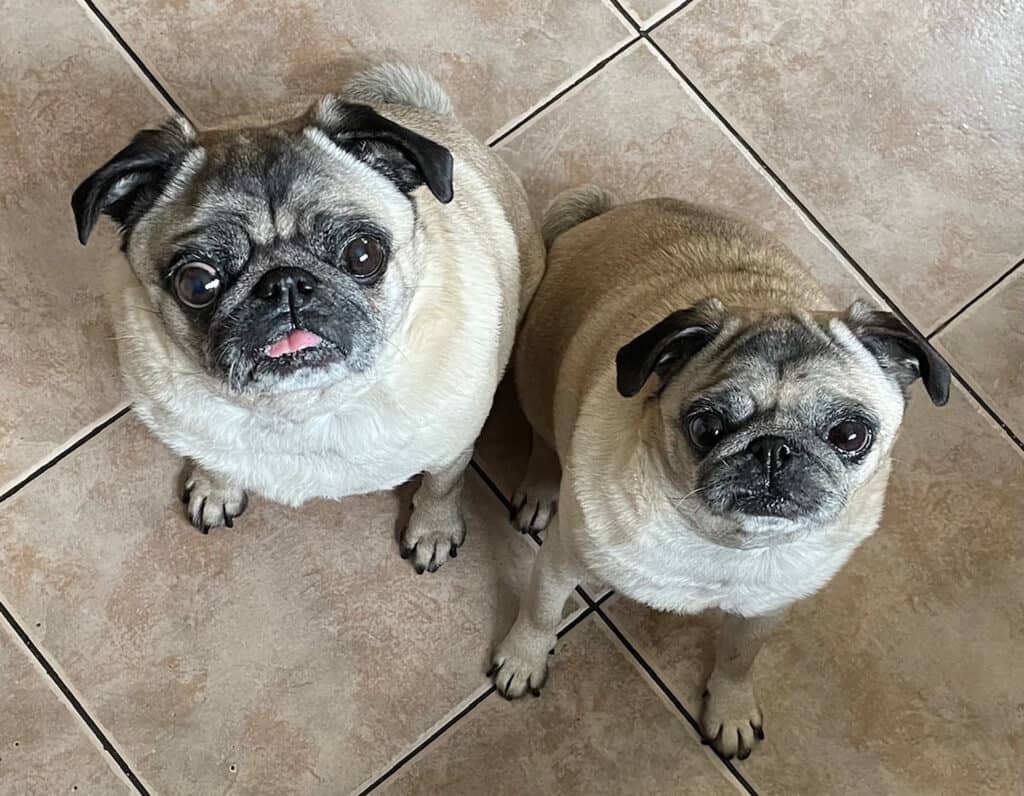
Arlo and Nori (as she was then) were 8 years old, a brother and sister in foster care. My family were a bit concerned that 8 was quite old for a pug, but to me, our job was to make the rest of their lives happy, for however long that may be. Jackie put me in touch with Louise, their foster carer, who quite clearly adored them. We had a good chat and Louise was able to answer all my questions. It was agreed that they would join our family, and in January 2024 I met a lovely volunteer transporter, Kevin, who delivered two bundles of fun!
They slept soundly through the night from day one, though we soon learnt they had to sleep together, and modifications had to be made to Henry’s custom-made Pug box to accommodate two pugs! Initially they were very reactive to loud noises but they soon calmed down, and fortunately we live in a very rural area so there is little to disturb them.
Louise had written us a letter explaining their routine and traits. I was told Nori was the more outgoing of the two. Compared to our other pugs she is tiny (and often gets mistaken for a puppy). However, she makes up with it in personality and she is absolutely fearless. Arlo was a bit more hesitant at first but loves nothing more than being tickled. If you stop, he will kiss you until you continue! He also loves having his teeth cleaned!
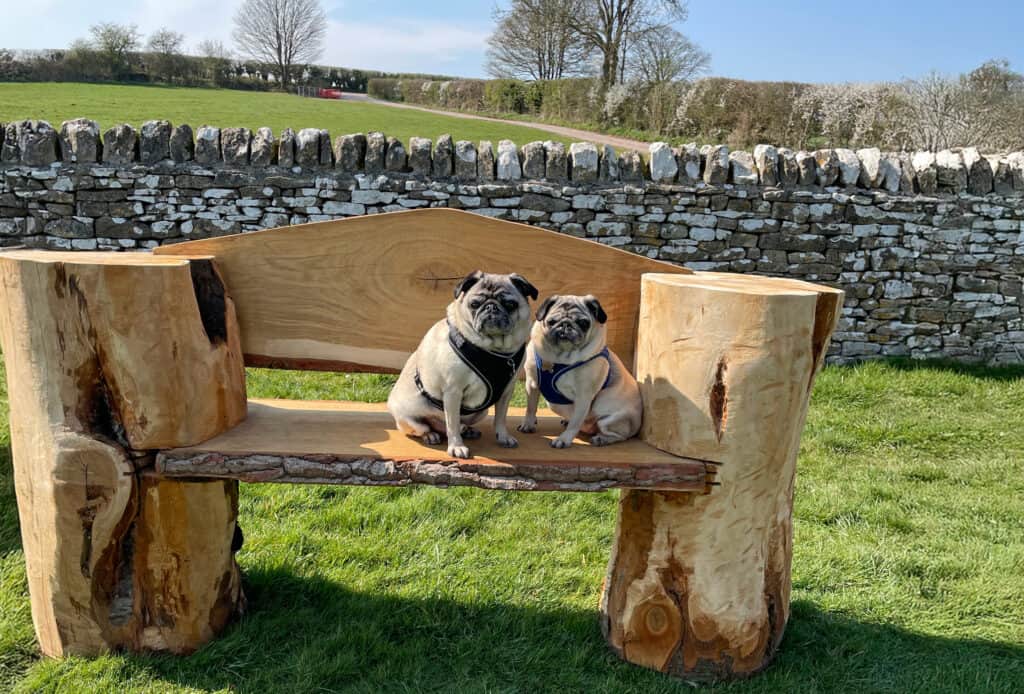
They both love food- show me a pug who doesn’t, but they are very active. We were told that before going into foster care they hadn’t really been walked much. Oh how different things are now. They love their walks and are ready to go every morning. In cooler weather they often go twice a day, but this is of course limited in summer. Arlo can run like the wind, and Nora does her very best to keep up. They have adventures all over, have visited the seaside, and also had an adventure in Oxford.
Last Autumn Jackie contacted me to say PDWRA had been approached by a film production company who wondered if they knew of a pug close to Oxford who would be able to do some filming for a documentary about dogs. We said that if it helped to raise the profile of PDWRA we would be more than happy, and I thought it would be a great social experience for the pugs. Arlo loved the bus ride and Nora was the star of the show, playing the role of Josephine’s pug during the French Revolution. Their adventure was documented by PDWRA in a previous newsletter.
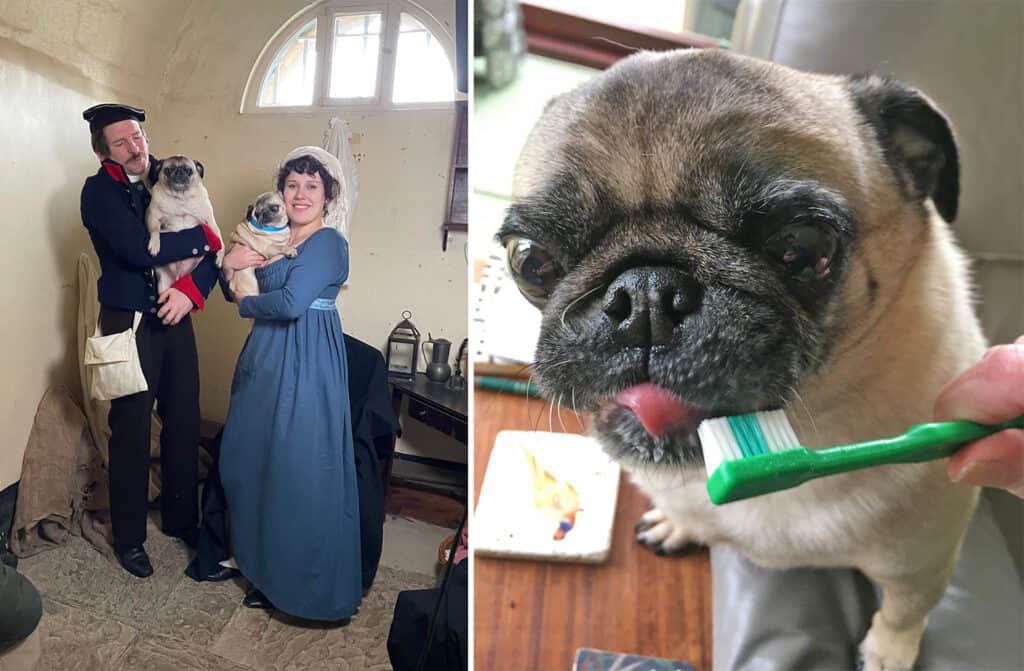
We have had a wonderful time with Arlo and Nora (Nora the snorer seemed far more of an apt name for her). The love and fun they give us is immeasurable. Recently they celebrated their 10th birthday, but although they have a few more grey hairs they are still living life to the full.
I don’t regret taking on two pugs, PDWRA did a brilliant job ensuring that they were in the best possible condition when we adopted them. I also believe senior pugs are wrongly overlooked. All puppies are cute, but they are not always the right fit. It may be that you get less time with older Pugs, and we all dread saying goodbye, but knowing they are going to have the best possible life really does make it all worthwhile.
Pugs are great companions. In my experience they are good with children, and ideal for many different lifestyles, but what they all crave is companionship, so you really do need to be able to devote time to them. I would wholeheartedly recommend adopting, but it is a huge commitment. I am so grateful to all the volunteers at PDWRA who cared for Arlo and Nora, helped us with the adoption process, and continue to help pugs who need support to find their forever homes.
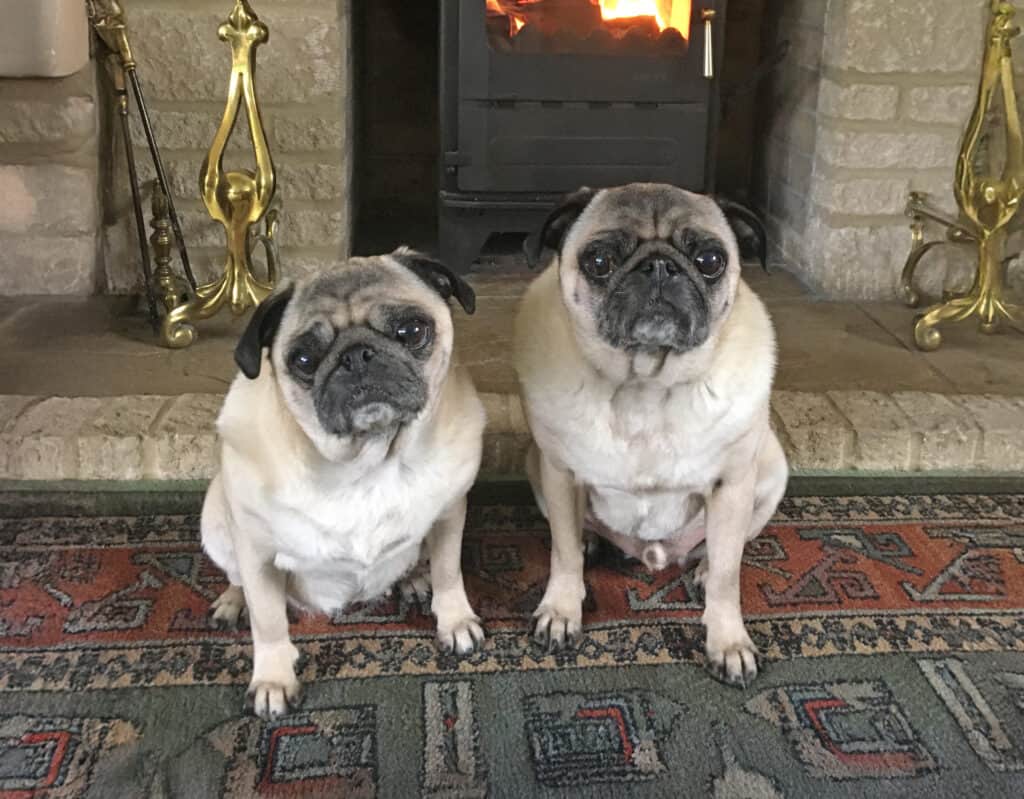
We will continue to support PDWRA as much as we can – their costs are so high and every penny raised really does make a difference. We are planning more pug themed Christmas cards this year, and hope that it will go some way to help. I would say to anyone if you can help in any way, please do. I know two pugs that very much appreciate it!
Best wishes
Jayne
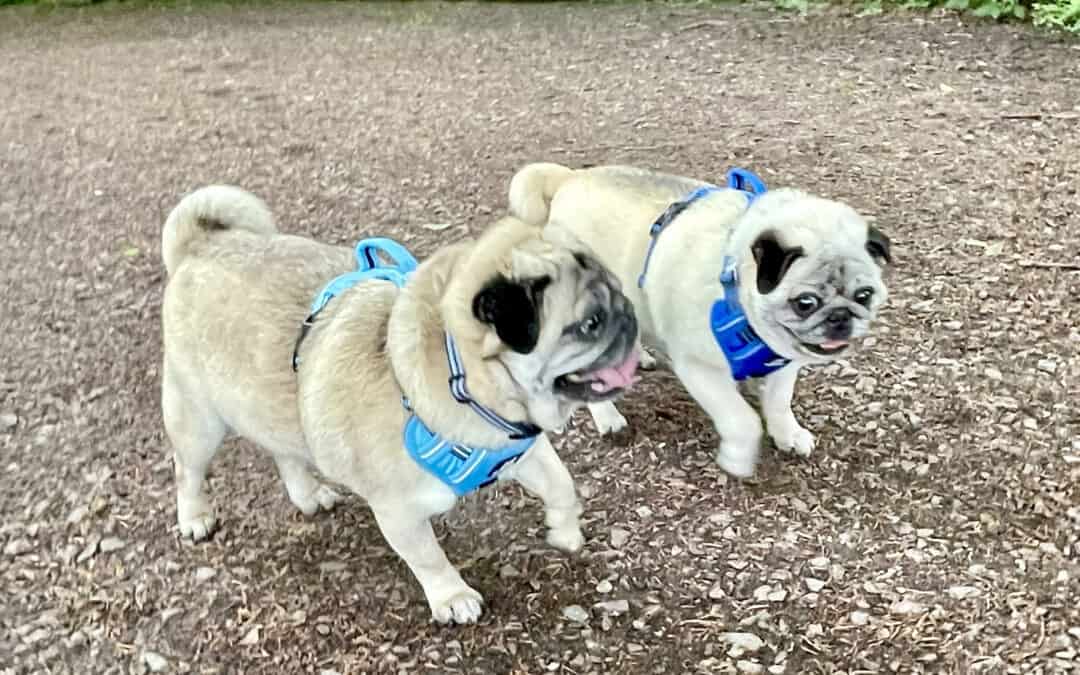
by Developer | 21 Oct, 2025 | Blog
Let me introduce Buster and Bentley, two Pugs that we adopted from PDWRA back in March 2023. They came to join me (Alan), Andrew and Mabel, who is our 11-year-old Puggle. For those who might not know, a Puggle is a cross between a Pug and a Beagle. Mabel has epilepsy and is a bundle of excitement and anxiety, although not a rescue dog, she is integral to the Buster and Bentley experience. So, let me introduce Buster, Bentley and Mabel (I know, they sound like a trio of gangsters!)
Andrew and I first came across the PDWRA when looking for a companion for Mabel following the death of her surrogate mother, Molly, in 2017. Mabel did not cope well after Molly’s death, and we didn’t want her to be a lone dog, so we started to look for a dog to rescue (note the careful use of the phrase ‘a dog’ in that sentence). An internet search led us to the PDWRA, and we conducted some research on Pug dogs as a breed. Eventually, we decided to apply and were told there might be a six-month wait. Two or three days after applying, we were sent this photo: –
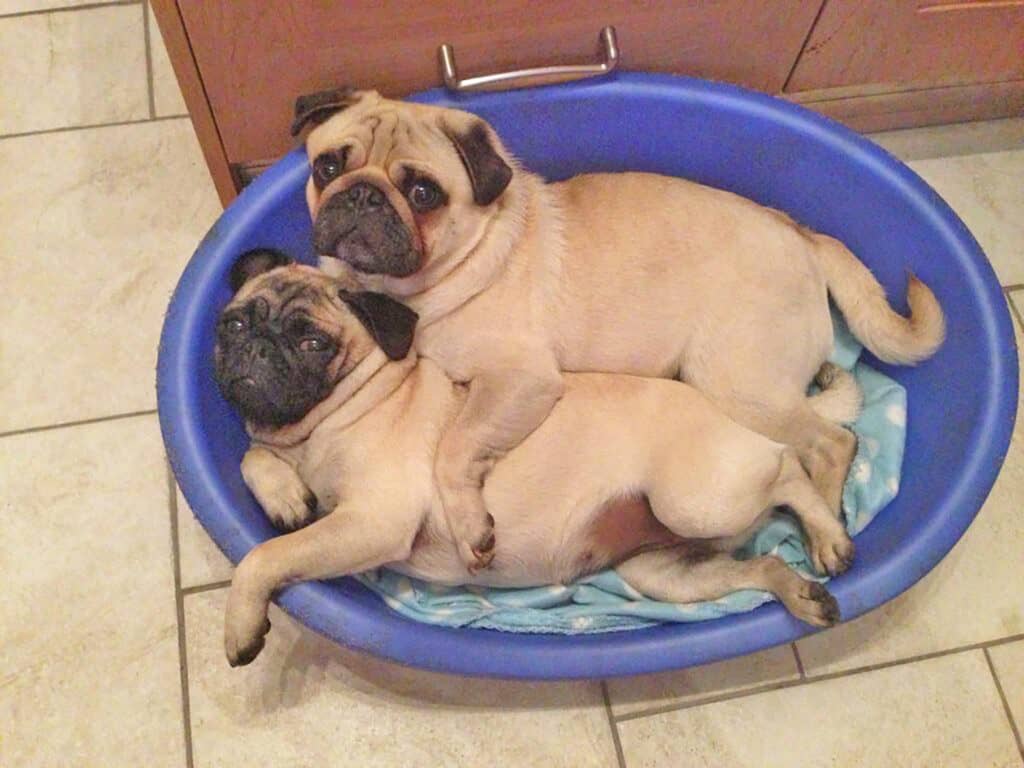
I’ll leave you to guess our reply, but needless to say, the ‘a dog’ became ‘dogs’ and we became a three-dog home. This was Teddy and Winnie. They were our first experience of Pug adoption. Sadly, we only had them for 5 years as they both succumbed to different forms of cancer. Their story is perhaps for another occasion, but for now, on with the Buster, Bentley and Mabel story.
Of course, you can’t ever replace one of your Pugs, but you can give a loving home to another Pug. We decided it was time to provide Mabel with another companion. We applied to PDWRA to adopt again, and as we were at the end of the COVID-19 pandemic, PDWRA had introduced online or virtual home inspections. This process was very straightforward and was more of a discussion to ensure we understood what we were taking on and what sort of help and support might be available. We met with a PDWRA volunteer home assessor, and I gave her a virtual tour of our bungalow and garden using my iPhone camera. All was well, and a short while later, we were asked if we would consider taking in two pugs who had been rescued from an unfortunate situation. They were bonded pugs who had jointly experienced neglect and poor treatment (we are not passing judgment, as we don’t know what led to the situation they were in; not all neglect is purposeful). Buster and Bentley had essentially been kept outside without adequate shelter and were not fed regularly. They were underweight and in poor nutritional condition. Buster had had fits, possibly due to being exposed to strong sunlight and unable to shelter. He was almost blind from a condition called pigmentary keratitis, requiring twice-daily Optimune gel to be instilled. Buster also had signs of arthritis in his forelegs and had muscle wasting in his back legs. Both of them had poor dental health and had to have extensive dental clearance work.
Buster and Bentley were, at this point, being fostered by the wonderful fosterer, Sophie. It just so happened that I was due to be in the area where Sophie lived, so I had the opportunity to go and meet Buster and Bentley before we gave a definite yes to them joining us. Here are a couple of photographs of their foster experience.

Sophie continued to foster Buster and Bentley for a few more weeks while they completed their various veterinary treatments. At last, the day came to collect them from Sophie. I was sad for Sophie, as it can’t be easy to let your foster Pugs go, but pleased for us as we started a new phase of life back home, back to being a three-dog home again.
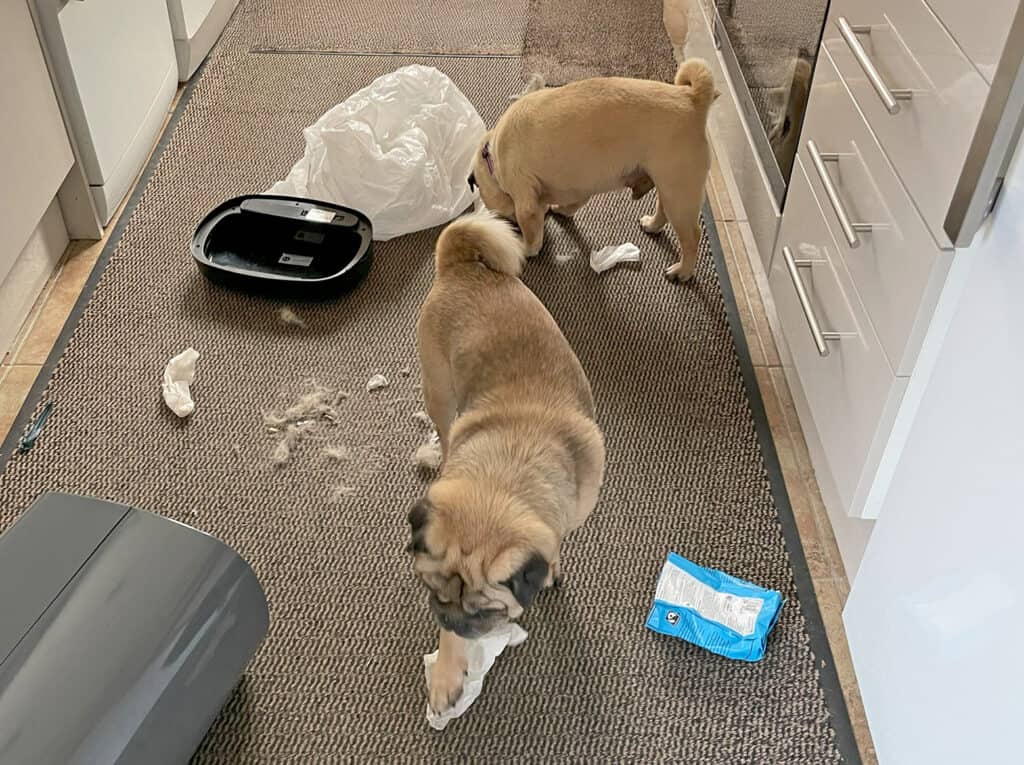
On arrival home, Mabel, Buster and Bentley all introduced each other in the usual dog fashion, extensive sniffing of areas most of us would rather not sniff! They got on well right from the word go. Buster is remarkably confident. He soon discovered the kitchen bin and realised he could easily tip it over and explore its contents. Bentley is more polite and reserved. Since he has been with us, we have come to the conclusion that Bentley is either going or is deaf.

Walking was a favourite pastime as it often led to lots of adoration from passersby. Recently, Buster’s arthritis, combined with a neurological deficit in his lower spine, has left him struggling to get back from walks, but he still tries and still enjoys the smells in the park. The photograph below is in our local park. The statue of the bear is called Bentley Bear. Bentley Pug is expressing his artistic opinion of the statue.
One of the favourite occupations of all three is sleeping, and they often sleep together.
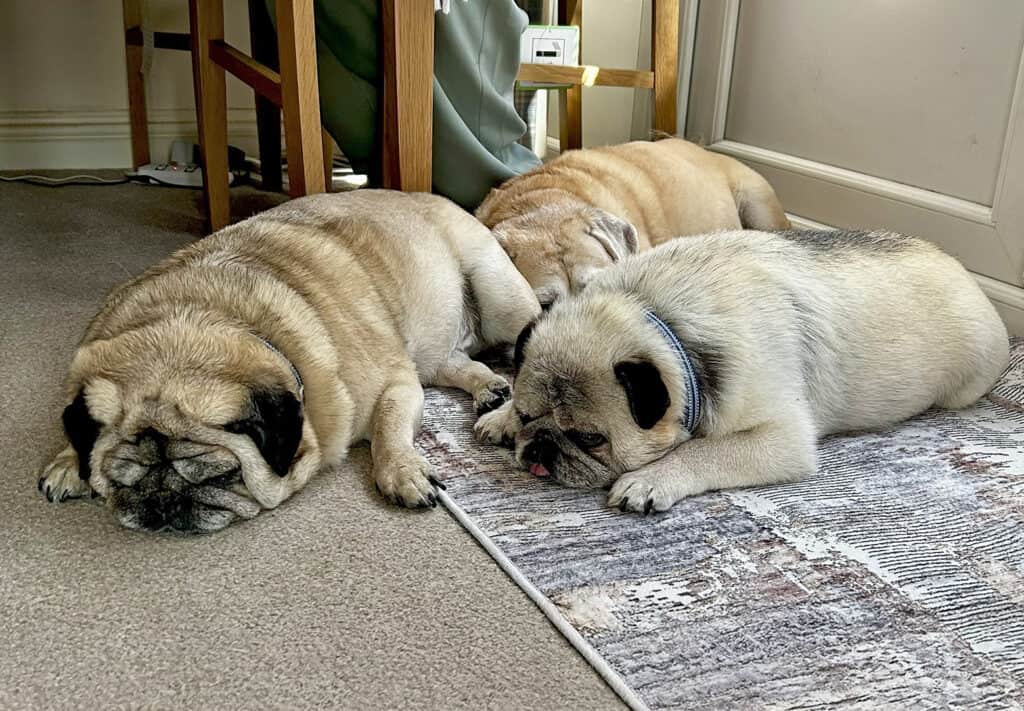
So, what have we learned from adopting Pugs? Well, firstly, if you want a source of unquestioning love and companionship, you couldn’t choose a more apt breed of dog. They are with you always, and I mean that in every sense. You cannot shake off a pug even if you wish to (but why would you?). They are around your feet wherever you are. You can’t move without them springing up, even from the deepest sleep, to follow you. If you go to the bathroom, they come with you. If you are lucky, they will sit outside and wait for you rather than going in with you, but if they stay outside, you will have to endure snorting noises under the bathroom door. It can be disconcerting at first, but you grow to love it. When there is no Pug in the house, it is too quiet. There is a reason the collective noun for a group of Pugs, grumble, exists. It describes the background noise that you will have in your house at all times – though I think it’s more of a rumble than a grumble.
There is a cost to all this love and companionship, and that cost is both emotional and financial. Buster and Bentley came with a range of illnesses that are long-term and need continuing care. Many of these conditions are common in pugs, especially as they age. Vet bills can be expensive. Bentley has an underactive thyroid and has to have daily medication. Buster, as mentioned earlier, has arthritis and eyesight problems that require daily medication. This, in addition to all the usual flea and worming treatments, as well as vaccinations. Our advice is to obtain insurance if possible, or else develop a strong savings habit to cover veterinary bills. As soon as surgery is called for, you are often likely to be into the thousands of pounds territory. Thanks to the wonderful PDWRA, the cost of Buster’s eye ointment, at about £40 a tube, is covered by them as it was an existing condition and wouldn’t be covered by insurance.
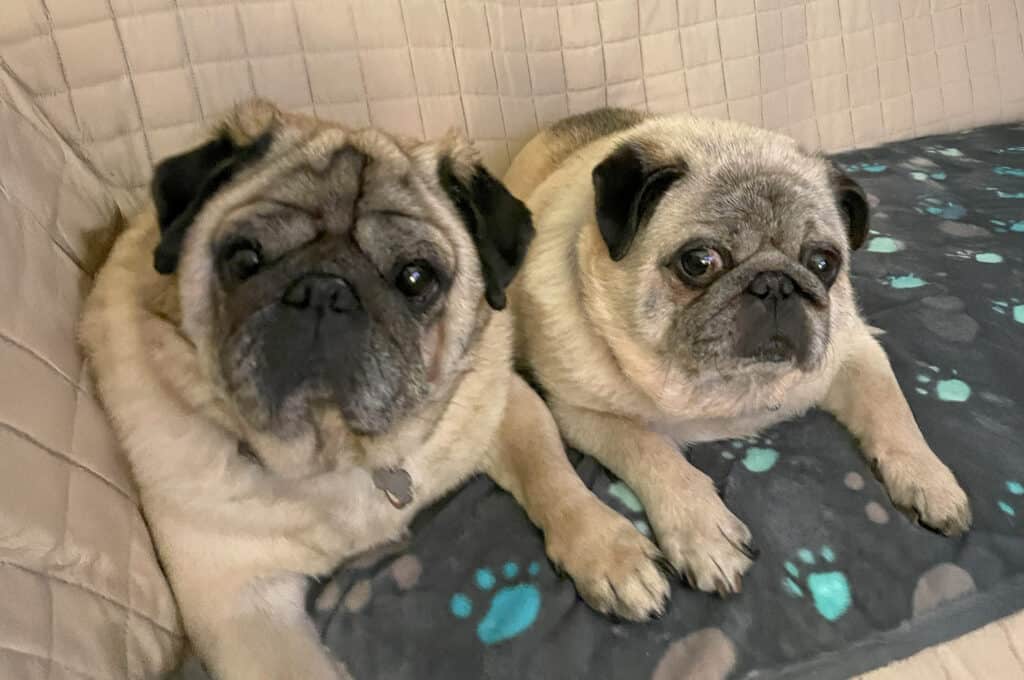
To end on a more positive note, despite the healthcare issues and the constant trips to the vet, the rewards of caring for a pug far outweigh the costs. We wouldn’t be without pugs in our lives and are eternally grateful to the PDWRA for allowing us to experience their devotion, companionship and entertaining characteristics. What’s more, please consider adopting older Pugs. They have so much love to give. It can be tempting to go for the sweet little youngsters, but we have found the oldies to be goodies and can’t recommend them enough.
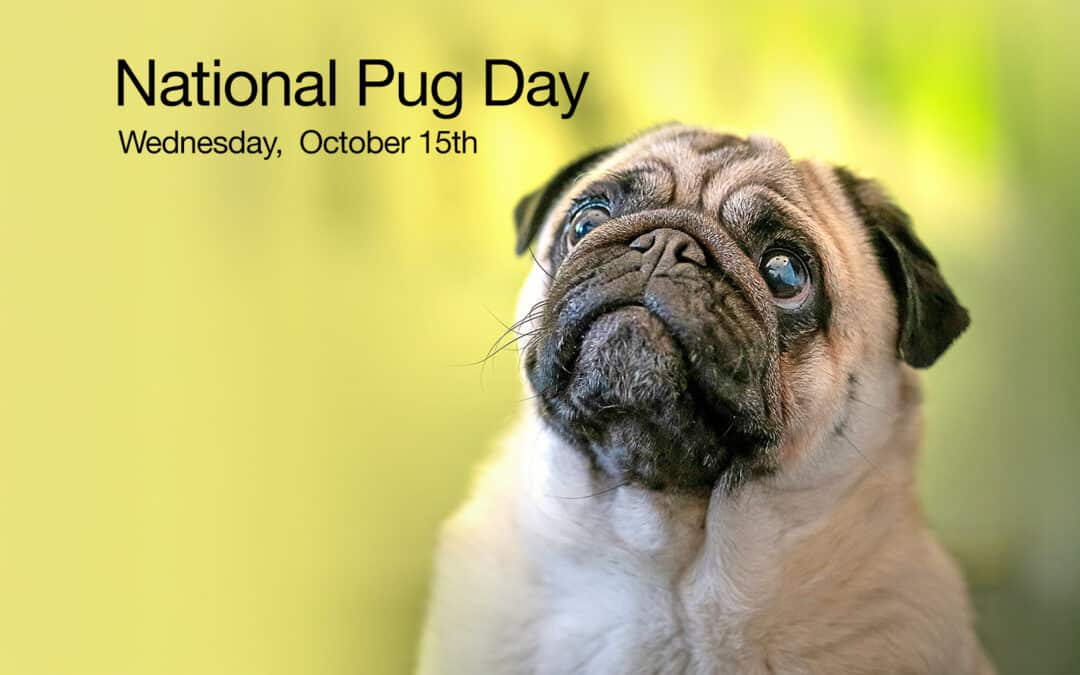
by Developer | 21 Oct, 2025 | Blog, News
Last week was that special day known as National Pug Day. Traditionally, it’s a day where we celebrate our beloved pug companions and no doubt give them a few extra treats…
To commemorate the day, we did a special competition on our Facebook page asking our followers to send in pictures of their pugs. The response was phenomenal, and we received around 2.500 great pictures of pugs from all around the world! Needless to say, sifting through them all took a little bit of time, it was certainly a labour of love though to look at so many beautiful pugs!
When we launched the competition, we said that we would pick our favourite 4 pictures and award prizes to the winners. However, it was impossible to pick just 4, so we ended up choosing 12! In reality though, they were all so good that we could have easily chosen our top 100…
For those that didn’t make the top 12, we’ll be showcasing a brilliant selection on our Instagram page over the coming weeks, and we can’t wait to share them with you.
If you’d like to follow us on Facebook and have the chance to enter more of our competitions, just click the link to head over to our page!
https://www.facebook.com/PDWRA
If you’d like to follow us on Instagram to see more of our brilliant entries, just click below…
https://www.instagram.com/pdwra/
Here are our 12 winners, as chosen by the Trustees.…
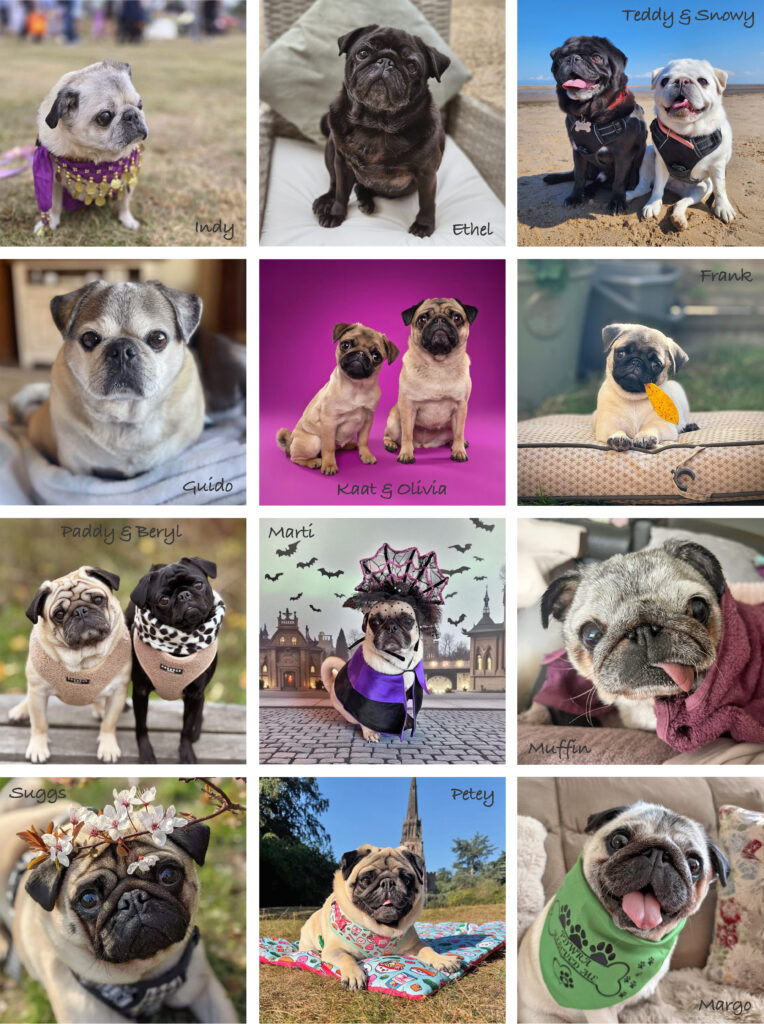
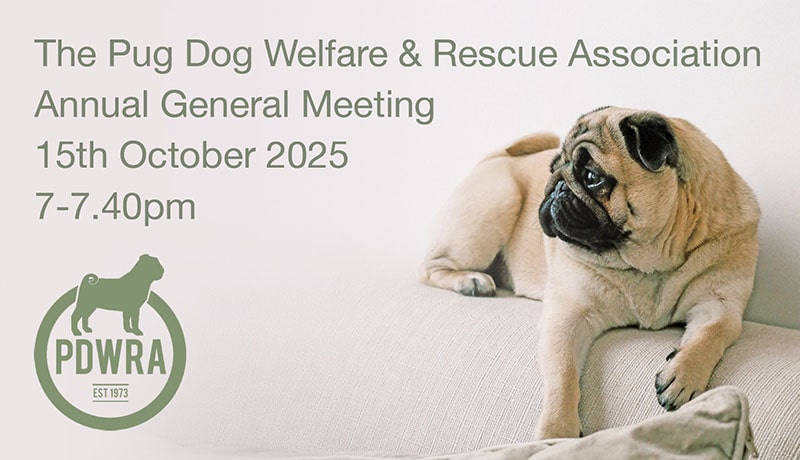
by Developer | 10 Sep, 2025 | Blog, News
The Pug Dog Welfare & Rescue Association’s AGM will take place on Wednesday 15th October 2025, from 7pm – 7.40pm.
The AGM will be held via Zoom, and we welcome as many of our supporters and members to attend as possible. We will be sharing an update of the charity’s activities over the reporting year and our key strategic developments to help take the charity forward and help even more pugs in the future.
Please do email us at secretary@nullpugwelfare-rescue.org.uk if you would like the link to join the meeting, please advise if you are a PDC member and/or a supporter – thank you.
If you have any specific questions for us, it would be most helpful to receive these in advance so we can be as prepared as possible on the day, and the meeting can run efficiently. There will be an opportunity for further questions from our members too where necessary.
Please note:
- You will need to have contacted us by no later than 30th September 2025 to share any questions and to receive the link for the Zoom meeting,
- In addition to the Trustees, only paid-up members of the PDC are eligible speak and vote, where necessary – thank you.
We would love to see as many of our followers attend as possible of course.
Kay Greene
Interim Chairman
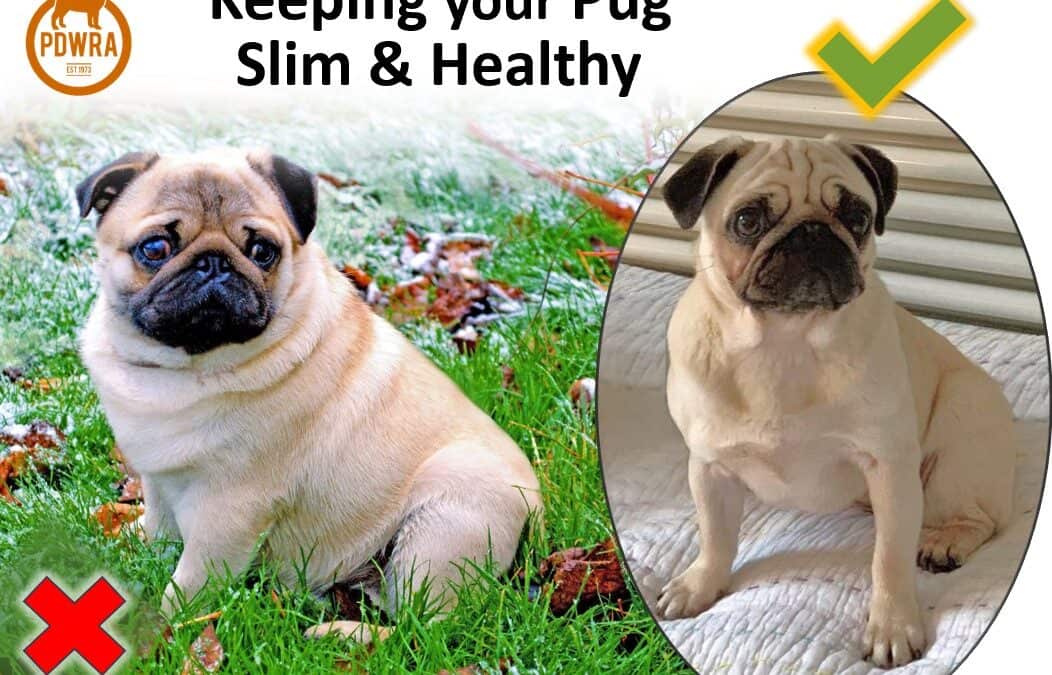
by Yasmin | 5 Sep, 2025 | Blog, Pug Health
As temperatures drop and Autumn/Winter approaches, our activity levels especially outdoors might reduce, with the potential addition of comfort and seasonal eating. So, it’s a good time to be particularly vigilant about our pug’s waistlines especially as weight creeps on easily, often hard to notice on a daily basis.
Pugs need to be slim, contrary to how many people perceive pugs and this so important for your pug to be as healthy as possible.
They suffer from many health issues that pugs are prone to, including breathing, spine and leg problems all of which are exacerbated when a pug is overweight.
The best way to check if your pug is the right weight, rather than its actual weight is by its Body Condition Score (BCS), where a BCS of 5 out of 9 is ideal. Probably slimmer than most people realise.
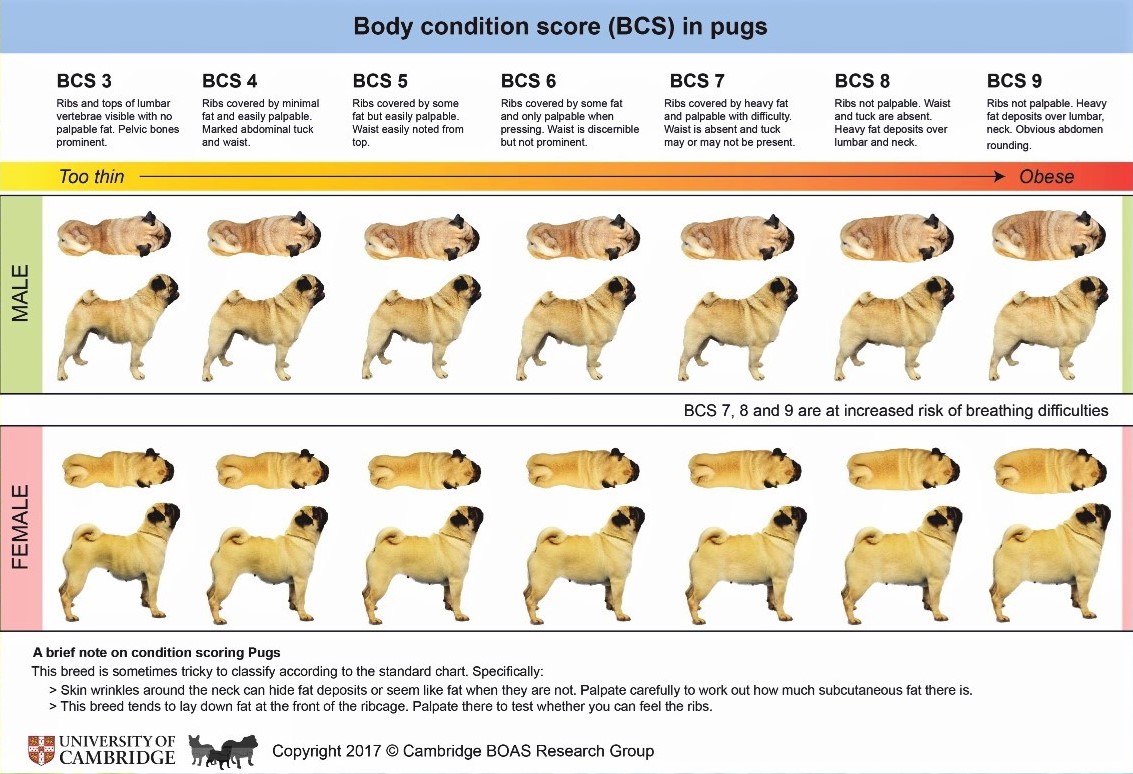
Pugs can live up to 15 years or more, and most will have health issues along the way, plus the breed is particularly prone to weight gain. Therefore the correct amount and quality of food, as well as regular exercise, is an important formula to keeping them fit and healthy.
It is important that you do not overfeed your pug as an overweight pug will find it difficult to sustain any form of exercise. They love their food, and unfortunately many of us are guilty of overindulging our beloved (and demanding) pugs by giving them extra treats and titbits from our food. Sadly, this means we could be killing them with kindness.
Obesity in dogs is classed as a welfare issue by DEFRA under their welfare legislation.
So, please see our tips and reminders on our Fit NOT Fat webpage for keeping your pugs slim and fit, therefore maintaining their general health and wellbeing, and longevity.
*******
For further Pug Health issues articles, please go to the following webpages:
Pug Health & Wellbeing | The Pug Dog Welfare & Rescue Association
&
Seasonal Hazards for Pugs | The Pug Dog Welfare & Rescue Association

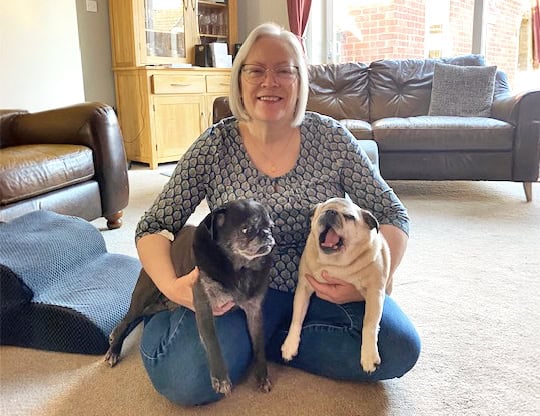
by Developer | 13 Aug, 2025 | Blog, News
Further to joining the trustee team as Interim Chair in mid-April this year, I thought you may find it helpful to have brief update from me about what PDWRA have been achieving these past few months.
One of the most impressive aspects of our charities work which warrants highlighting is the ongoing care, support and love we provide to the owners and foster carers of pugs surrendered to us. Between 1st January – 30th June this year over 220 individual pugs, under our care umbrella, some with us from as far back as 2016, received veterinary care at a cost of just over £110,000. This averages out at circa £500 per pug, however, the reality is one pug’s veterinary care bills alone were as high as £3500. Fundraising to ensure our beloved pugs get the right care, at the right time and in the right place is a key strategic objective for the trustees and will feature in our Charity Development Plan. We also recognise and appreciate the huge amount of support and voluntary funding we receive from our loyal supporters as well as the amazing efforts of the PDWRA’s Mega Auction Facebook fundraising group – on behalf of all our pugs helped, thank you all.
Fundamental to ensuring the charities ongoing success is our highly valued volunteer team – roles ranging from transporting, home checking, foster care and area co-ordination are some of the essential roles we have well established. We have undertaken our first satisfaction survey with our area coordinating team and we are now working together to agree an action plan on areas they have highlighted where we could improve our operational approaches. One example of an improvement has been the introduction of a pre-paid payment card enabling the immediate veterinary bills ultimately reducing invoice flow and time spent by our treasurer etc.
We are delighted with the interest we have received in becoming a Volunteer Area Coordinator with us, this will help us in our structured, considered phased re-opening of areas to surrender pugs as regrettably due to insufficient volunteer resources we had to temporarily suspend our operational activities – with exception for extreme welfare emergencies. We would like to take this opportunity to thank the charities with similar objects to ours for their ongoing support in accepting pugs in need of surrender during this time. We are also extremely pleased with the offers of voluntary help from a range of veterinary professionals received. We are looking to develop a new framework for how our veterinary advice and support will be available for our Volunteer Area Coordinators as we say farewell and sincere thanks to Volunteer Veterinary Advisor Helen McKee after many years of dedication and commitment – more about Helen features later.
Another aspect of work the charity has been doing is to engage an animal welfare specialist law team to ensure our approaches (e.g. transporting) and documentation (e.g. adoption form) are operating within legal frameworks – at present there are varying laws in the countries we cover and the charity trustees need to consider the implications of such variances and how we ensure we remain within the necessary legal parameters for all our operations.
The review of the charity’s status within the Charities Commission domain is also a key strategic objective, the charities objects and operating framework have not been assessed since 2014. Again, the charity is using animal welfare specialist law team to ensure the charity is compliant with the legal processes necessary to move into a more contemporary operating framework. You can hear more about this, and all our accomplishments at our forthcoming AGM scheduled to be held virtually at 7pm, October 15th – we would love to see as many of our followers as possible! More details about the AGM are featured later on and will also be available via our website and social media platforms.
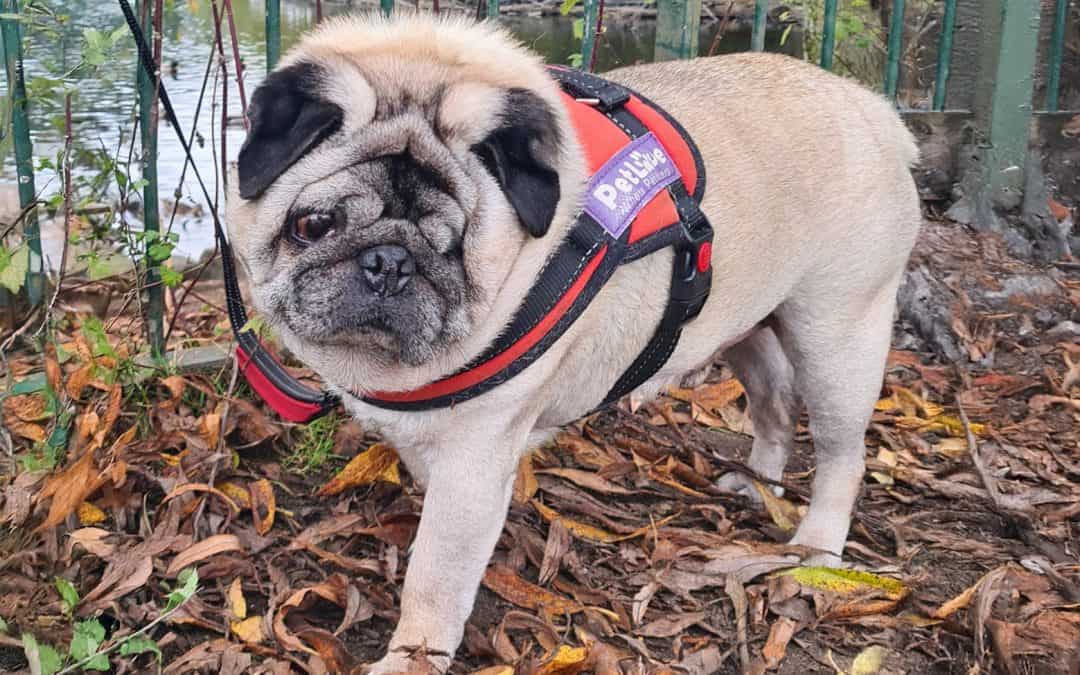
by Yasmin | 7 Aug, 2025 | Blog, In Memoriam
We lost one of our stalwarts of the pug world on 19 July 2025. Dear old Ralph who coped with a multitude of problems throughout his life but despite all, took and gave pleasure to those who came across him
Ralph was surrendered in 2019 by a lady who saw him advertised on Facebook. She took him on with the best of intentions but a combination of family circumstances and Ralphs physical and mental needs dictated that she could not care for him long term. He was blind, one eye removed after a dog attacked him, the other became infected so much that it left him with no vision at all. He had been confined, and due to the disorientation suffered from loosing his sight, barked and span round in circles in frustration and despair. Knowing all this, Caroline took him on to foster and gave him all the love and understanding he needed. He gradually improved as his confidence grew, and led a contented and stimulating life.
I met Ralph in June 2021 when I collected Poppy, also being fostered by Caroline. He was a cheerful little chap then, despite his disabilities. Poppy was quite a dominant pug and it was thought best for both if they were parted.
The next I heard of Ralph was in August 2024 when I received a call from Caroline’s daughter to say that her Mother had passed away. She, nor any member of the family were able to care for Ralph, especially with his multiple needs.
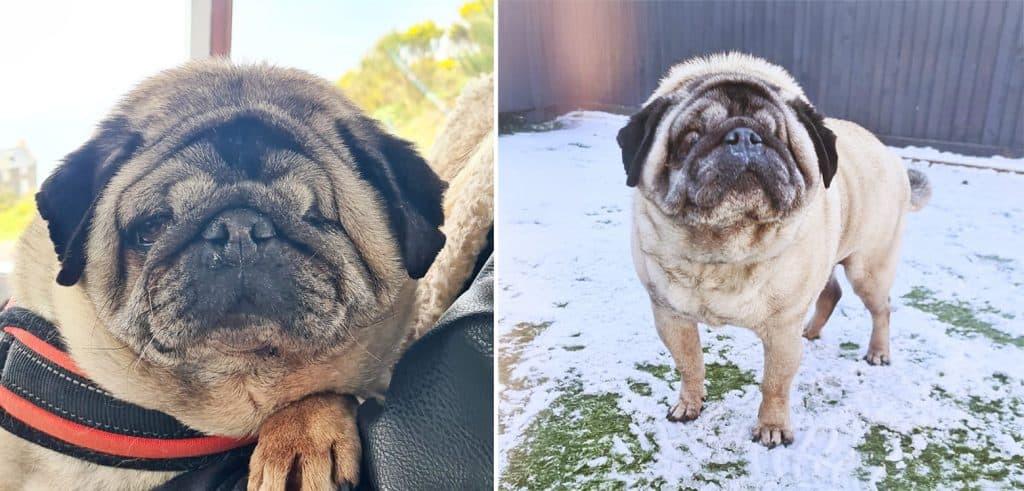
Even with our dedicated band of Foster Carer’s it was a challenging remit to find a new placement for Ralph. Louise stepped forward however, and said she would see how it worked out. She is caring for Albie, another veteran, so thought that one more should be no trouble. After a challenging first few weeks, Louise and her family gradually got to know his ways and he soon became a much loved member of the family.
Ralph’s condition by this time had stabilised, and although still needing extra care, Louise was able to fill his life with stimulating and rewarding experiences. At first believing he was totally deaf, she later discovered that he could hear – the ping of household applicances, the applause at sporting events on the TV (Louise was sure he thought they were applauding him ! (He became a big fan of tennis ).
Louise only had the pleasure of his company for eight months but all four seasons were packed into that time with him. He loved to visit Stately homes and Markets, visited the seaside and had a ride on a steam train. But his favourite time was the evening when cuddles on the sofa in front of the TV were the order of the day. So many memories packed into such a short time, how he will be missed. Rest in peace you dear, brave little man.
Jackie Maynard
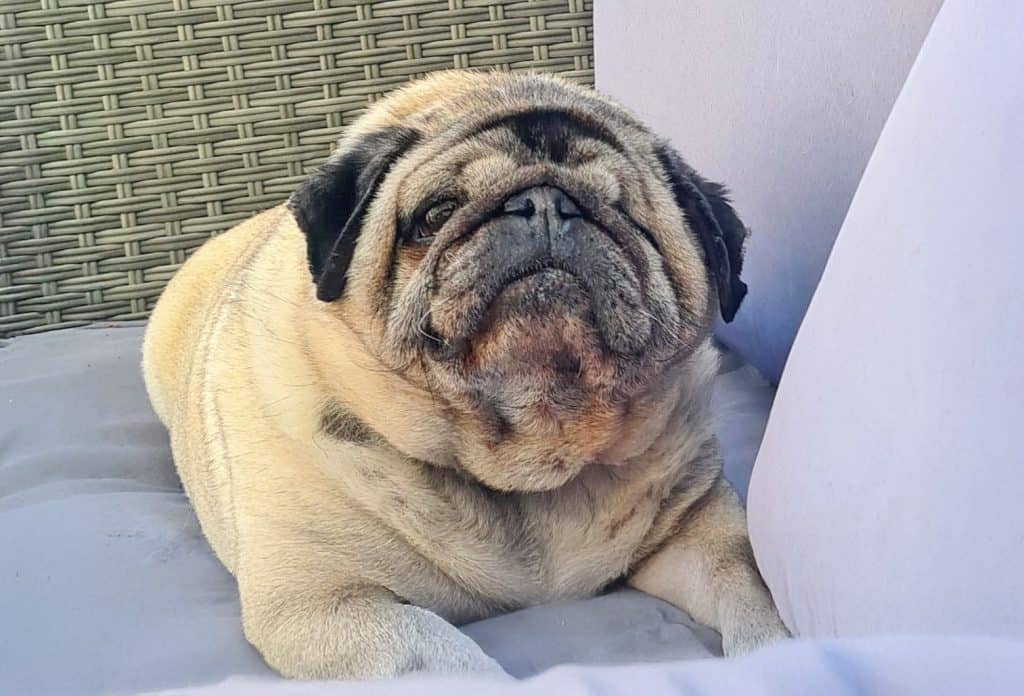
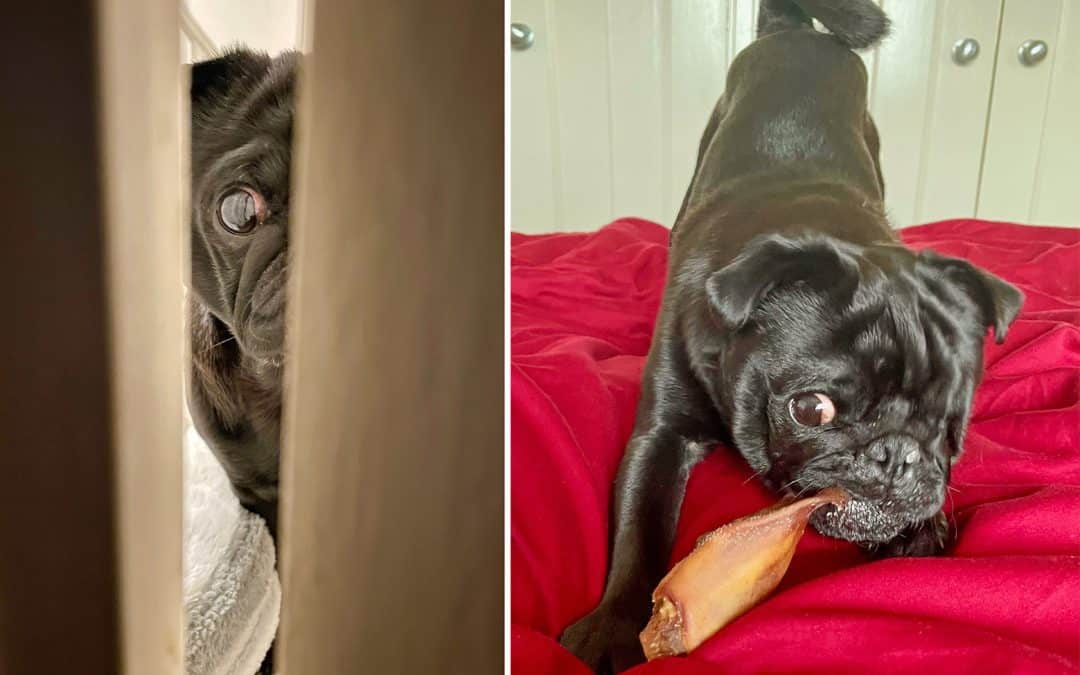
by Yasmin | 7 Aug, 2025 | Blog, Rescue Stories
We are a family of dog lovers who had dogs in the past, but when I had some health problems and we weren’t sure whether we had the capacity to offer a dog a long term home.
We’d been a dogless family for several years and we were all yearning for the pitter patter of little paws around the house. I’d never considered fostering before but when I started researching rescues online it became very clear that rescue charities were desperate for fosterers, and this seemed like a good option for us – a way to help a dog in need without the permanent commitment, just in case it didn’t work out. At first, my husband was worried that fostering was cheating somehow, or that we’d be jumping the queue if we did want to adopt, but when I showed him how much charities needed fosterers, he was soon onboard. Out of nowhere, our son suddenly developed an obsession with pugs, and after a quick internet search we found the PDWRA and our lives were changed forever!
We submitted the application form to become fosterers and had a home visit with a lovely PDWRA volunteer to check our home was suitable. We didn’t tell our son it was a pug charity, just that we were interested in fostering a dog. A couple of weeks later I had a call from the Volunteer Area Coordinator (VAC) for our area asking if we could take a foster in, and so our foster journey began.
We quickly fell in love with fostering and all adored having a dog around. Our son was over the moon to have a pug in the house, and we soon adapted to life with a dog again. The first foster was difficult to say goodbye to, but we all agreed that we weren’t quite a perfect fit, plus, the PDWRA had found a perfect home. It was strange to have a quiet home again, but we were so excited when we got ‘the call’ from the VAC about taking another foster pug.
We’ve fostered 7 pugs through the PDWRA in total, and very much hope we can foster again in the future. Each pug that came to us had their own unique personality and challenges. The PDWRA were always on hand if we needed support or guidance. With each new pug it was getting increasingly difficult to say goodbye. We felt we could offer a great temporary foster home, and that was often helping a dog coming from difficult circumstances, but I still worried that it wouldn’t be fair on a dog to adopt due to the complications of my health issues.
Then came Ozzy.
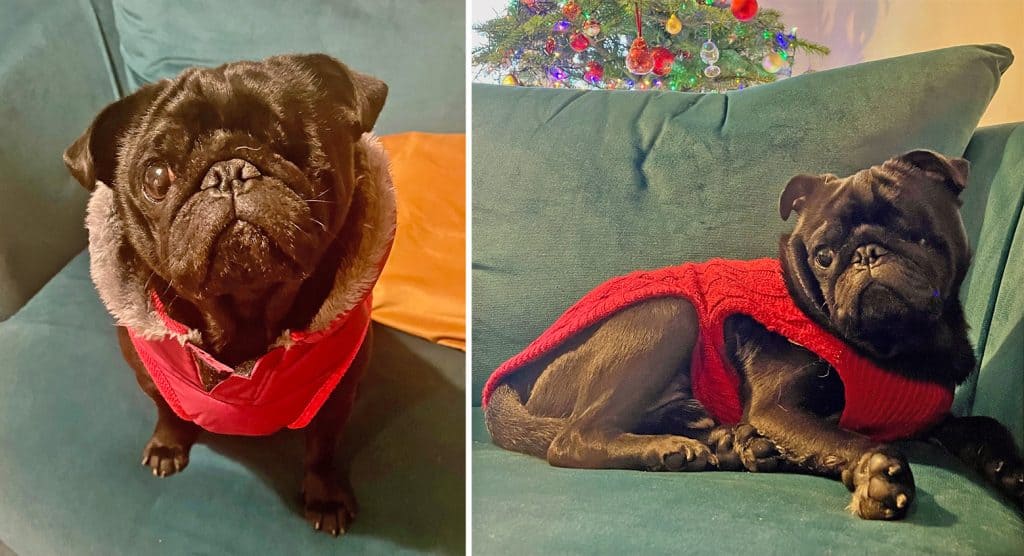
Ozzy came to us as a foster in April 2024. He’d had a difficult start in life. While we had no intention of adopting, as we’d really enjoyed fostering, there was just something about Ozzy’s energy, he just seemed so happy to be with us. He was lapping up all the attention and as each day went by, I saw him become more grounded, as if he were saying ‘ahhh, I’m safe now’. We felt this overwhelming feeling that he was home. We also felt that it would have been just too hard to say goodbye, and that despite the challenges of my health, he didn’t care about that one jot, what we had to offer was enough for him.
So, we quickly let our VAC know and once we’d had all the fostering medical assessments sorted, we signed the paperwork and transferred the adoption fee (we’d already had a home check to become fosterers). All very straightforward.
Ozzy came to us with a few health issues – allergies and eye issues, but the PDWRA have been so helpful in guiding us through managing these. He did need some support with his behaviour too, as after a difficult start in life, he struggled to feel safe – especially around new people. He had sadly lost one of his eyes due to neglect before coming to us and was understandably not a fan of the vets, or people touching his face and head.
With a lot of love and patience, Ozzy has come on leaps and bounds! I always loved to see the progress our foster pugs made with us, even though they were only with us for a few weeks. Watching Ozzy blossom over the last year has been wonderful and leaves me with an enormous sense of awe! He’s doing so much better with people and is so much calmer. He’s been socialising with dogs and people, and we very much hope that if he continues to improve we can foster again, so that he has a friend every now and then, as he does love to play.
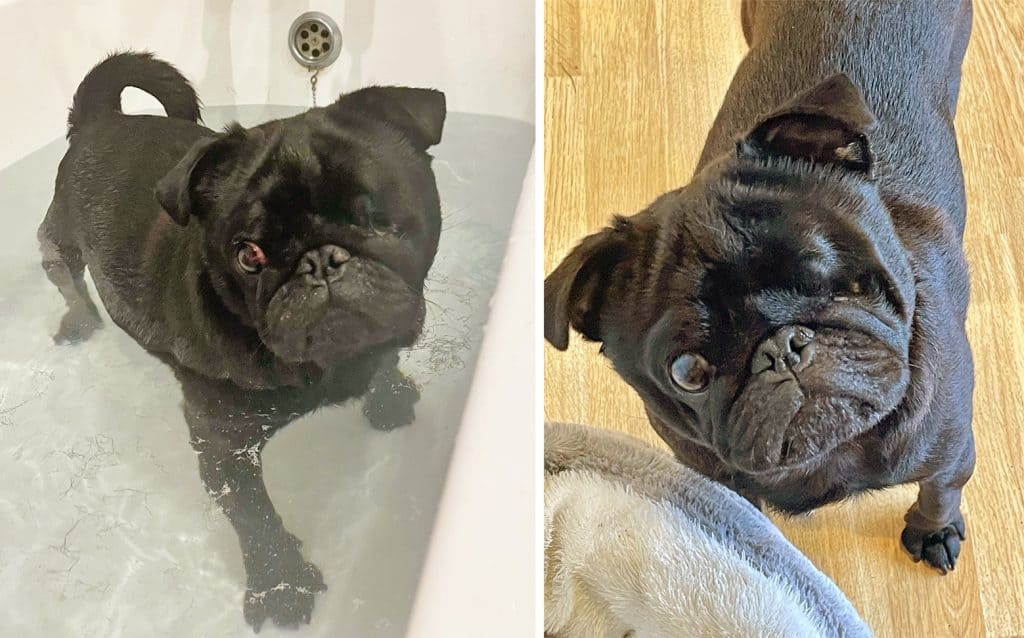
Ozzy can be so funny and mischievous, but he’s also so bright and quick to learn.
His zoomies around the garden are always a joy to behold and the way he scratches the kitchen bin to demand his dinner makes us laugh.
Like a typical pug, Ozzy is very food oriented – which has come in handy for training, but also gets him into mischief – he quickly learned that there were delicious delights to be found in the strawberry patch! At first, we couldn’t quite understand why we weren’t getting any strawberries, then we figured out it was just our cheeky boy getting to them before us!
We initially had some challenges with Ozzy and my 10-year-old. At first, Ozzy could be triggered by people moving suddenly, and children are not known for their ability to keep still. However, with time and patience and lots of love, they are doing so well together. We got my son to feed Ozzy every day, go on walks together and get involved in training. Now Ozzy sleeps on the end of my son’s bed each night – we actually ended up getting our son a bigger bed so they both had more room! They love to snuggle and run around the garden together.
My husband says: “It was great fostering, but life feels complete with little Ozzy. I love taking him to the local cricket ground and watching him run with his friends, 2 big Labradors. They’re so much faster than he is, but he perseveres. Due to having only one eye, he can sometimes veer off to one side and gets lost but soon finds his ways back to us. We live out in the countryside, but without a dog I forget to get out and enjoy it. My morning walks in the fields with Ozzy are so peaceful and calming.”
I’ve always been highly impressed with working with the PDWRA. The positive community ethos they have fostered is wonderfully supportive. Our Volunteer Area Co-ordinator, Dee, has always been amazingly understanding and helpful! Thank you!
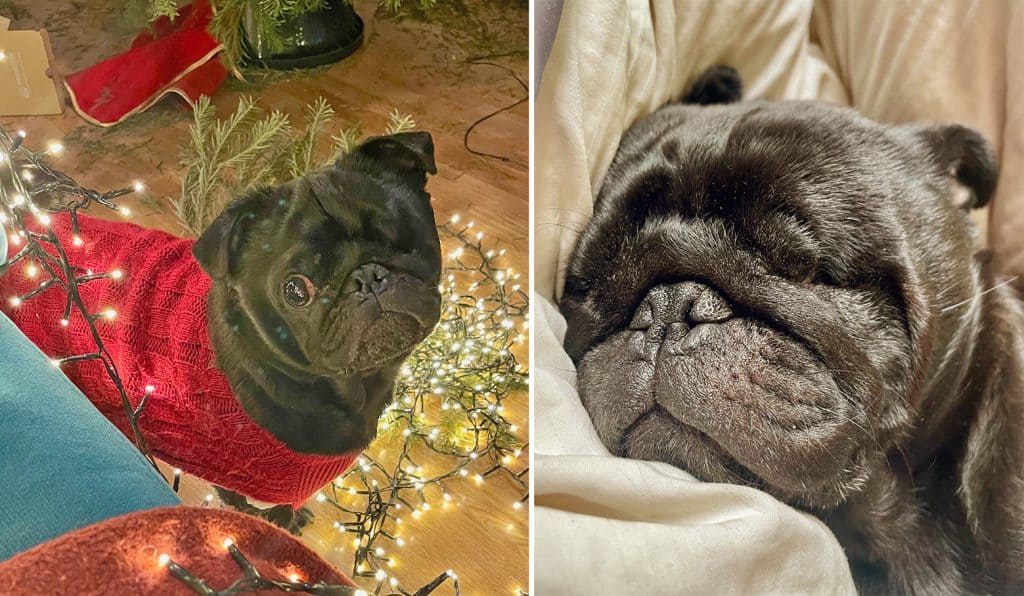
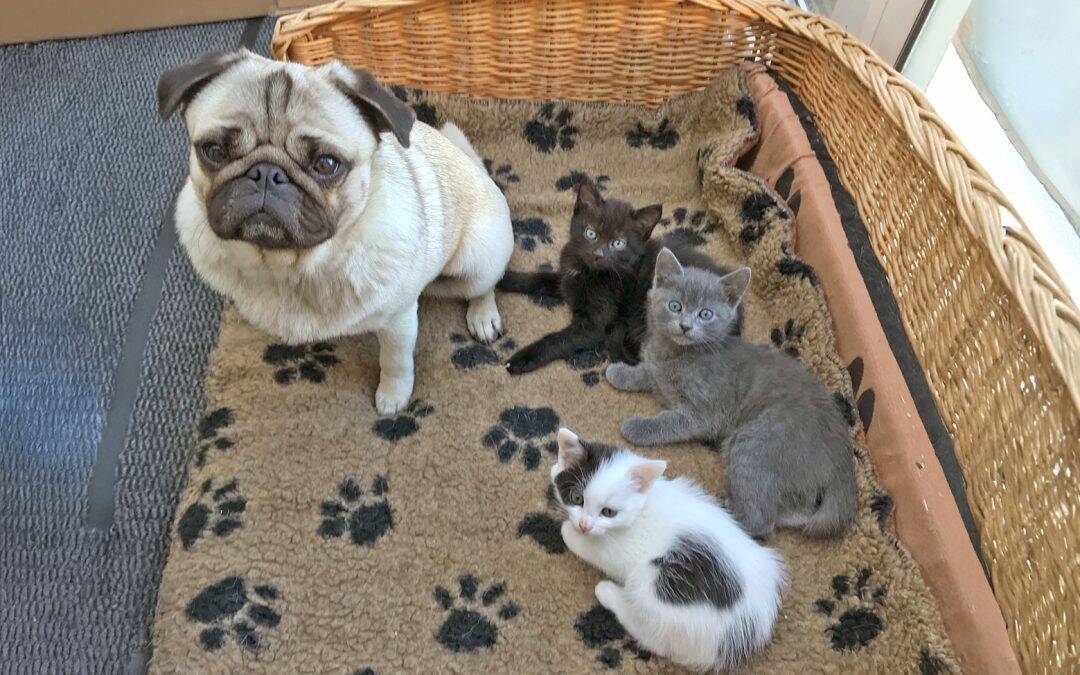
by Yasmin | 7 Aug, 2025 | Blog, News
Iris hanging out with the kittens
Meet our new Trustee – Anne McDonald
My name is Anne and I’ve recently become a Trustee for PDWRA. This is a bit about me…
I’ve been a dog owner from the age of four, my grandad’s dog had puppies and he gave me one for my birthday. She was a mixed breed called Trixie, since then I’ve never been without a dog. My first dog after getting married to Dave was my beautiful Rottweiler Roxy. She was joined by another Rottweiler and a Labrador; I’ve also owned a Bullmastiff and a Border Terrier. I now have pugs!!
I’ve worked as a Local Authority Dog Warden since 1989; I was the first full time warden to be employed at the authority and during my first year over 600 stray dogs were picked up and taken to our kennel. Needless to say, I wasn’t the most popular person at the authority! I absolutely love my job, it can be very challenging, heartbreaking at times but also so rewarding.
During the working day I can be involved with stray dogs, dangerous dogs, noisy dogs, cruelty, dogs causing a nuisance, dealing with animal licences including Riding Establishments and the keeping of performing/ dangerous animals, and anything else that the office thinks I can do. I’m also a fully qualified pest control technician and a licensing officer.
I have two grown up boys, one’s a history teacher and the other works in theatre. I like fast cars and fast horses, I’ve ridden since I was 9 years old and did work with horses in my younger days, I was a qualified teacher and did enjoy teaching. I’ve owned my own horses, usually thoroughbreds, but sold up after breaking my back in 2010. Anyone who has horses knows it’s in the blood, so I do ride as often as I can. My other great love is the theatre, and I go as often as I can, either local or to the West End.
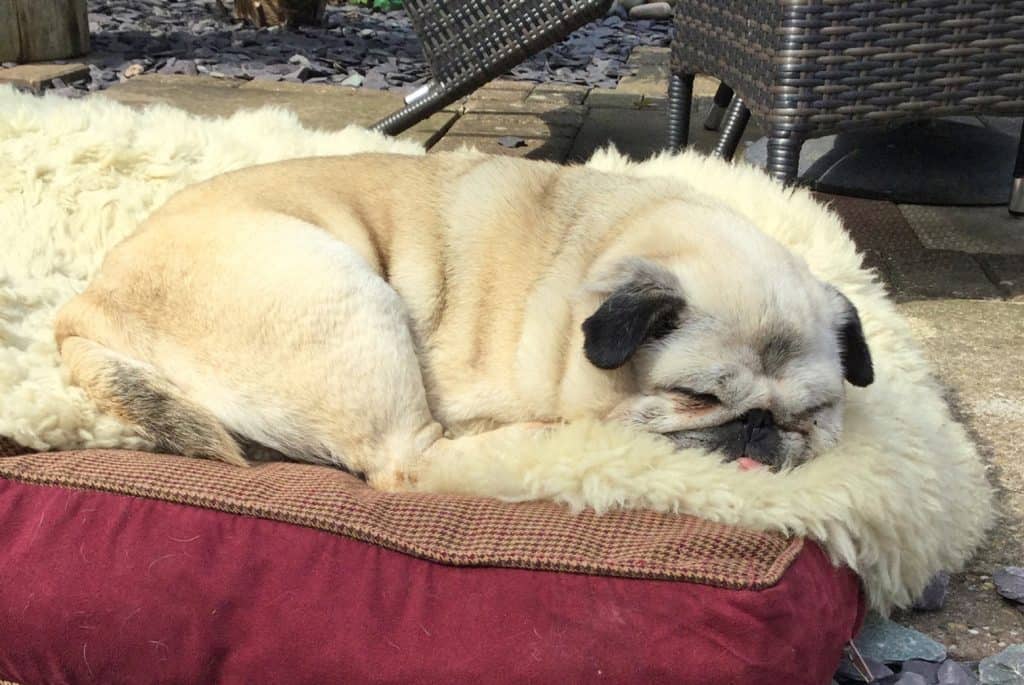
Anne’s first Pug – Lucy
My first introduction to pugs was when I got called to a property where the occupant had died and a pug was left inside. His name was Charlie Chan and what a character he was. I remember contacting PDWRA and the lovely lady I spoke to, who was very well spoken, said “my dear, are you absolutely sure that it’s a pug?!“ They subsequently came to collect him, as we have always tried to work with breed rescues.
How did I end up living with pugs? Well, I had been dealing with a backstreet breeder for a while, removing dogs she no longer wanted. On one of the visits, a little fawn pug was in a tiny green cat house completely wired up with hardly enough room to turn around. I said to the owner that if she no longer wanted her I’d take her to rescue. 18 months later there were two pugs, this time she’d put them in a shed. Again, I suggested letting me have them but she said no, however, I was on my way to the kennels with a Labrador when she phoned to say she no longer wanted the pugs as they kept jumping up on her! Honestly, I think the poor Labrador got whiplash as I turned around so fast, and this is how I ended up with Lucy and her daughter Minnie.
Neither had ever been walked, or seen the great outdoors, and a short while later Mikey was born to Minnie, as she had been mated before I had her. I ended up paying for a caesarean and of course I kept the one puppy! I’d never really thought about having a pug or two, as I didn’t really know much about the breed. I’ve always loved big breeds and terriers, which was where my knowledge was, but was thinking ‘they are just dogs aren’t they? How difficult can they be?!’ Haha, as any pug owner knows, they are totally unique. How silly was I?!
Dave was at work when I brought them home and had no idea they would be joining us! He didn’t think he liked pugs, that was 24 years ago! We then adopted Alfie, who was from Leicester Animal Aid, the charity we use for our stray dogs. Alfie had two unsuccessful homes after being gifted to the centre, then I was greeted with ‘Anne you’ve got pugs, haven’t you?!’ So, Alfie came to live with us, a super little pug who was never a problem in any way. He lived to the grand old age of 15.
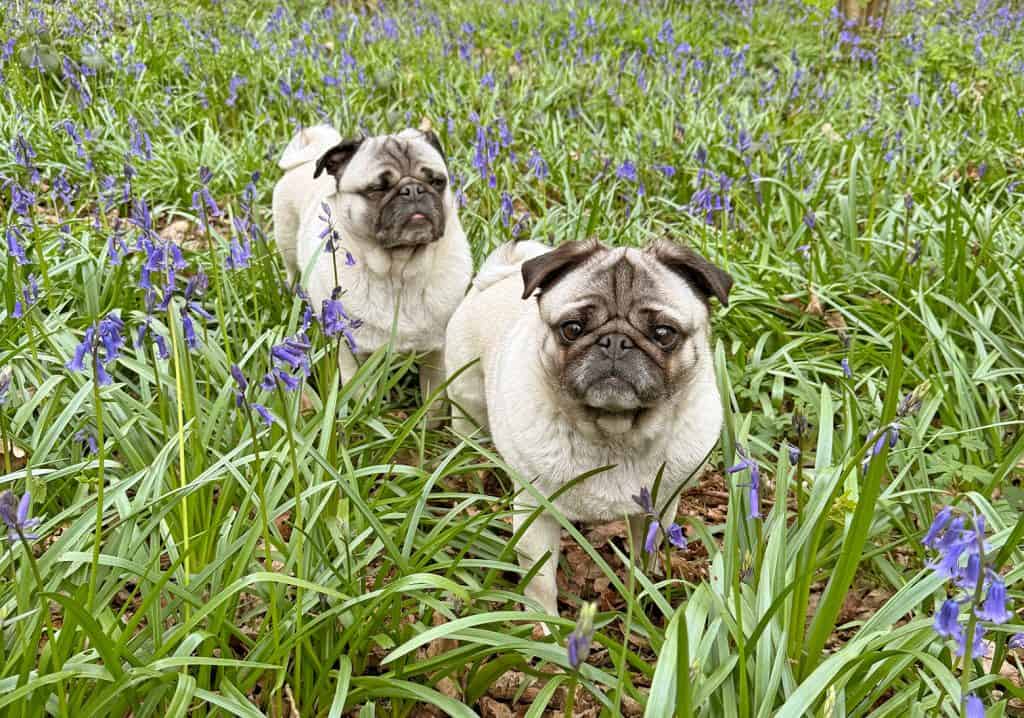
Bertie & Iris out for a walk
After losing Lucy, Minnie and Mikey, I bought pugs for the very first time, which are the two I’ve got now, Bertie and Iris. I have adopted a pug from PDWRA, but sadly lost him aged 8. Percy came to me as a pug that would bite, and he did, quite a few times! Although I’ve had many foster pugs I wasn’t happy about Percy moving on, so I adopted him. He was quirky, but lovely! He absolutely adored Dave and never made any attempt to bite him!
Bertie and Iris are now 8 years old, they have been to Crufts, to discover dogs and on the PDWRA stand. They are typical pugs and are happy to go anywhere, as long as they are with you, they will travel around London on the tube or bus, they love Richmond Park and always enjoy a beach walk with an ice cream at the end. They live with 4 cats and 2 tortoises, their very best friend is Thor, a German Shepherd I rescued as a very underweight puppy who now lives with my friend. This is one of my happy endings!
I have been involved with PDWRA since 2014, first as a volunteer, then as a VAC. When I knew they were looking for Trustees I applied, as I felt my knowledge of dogs, dog behaviour and dog law could be helpful. Aside from that, doing the other roles gives me an insight into what goes on and how much work the volunteers do.
Going forward I would like to see a joined-up charity, with everyone working together and helping each other. It’s so important to have a charity dedicated to the breed, with volunteers who are very knowledgeable and able to give helpful advice.
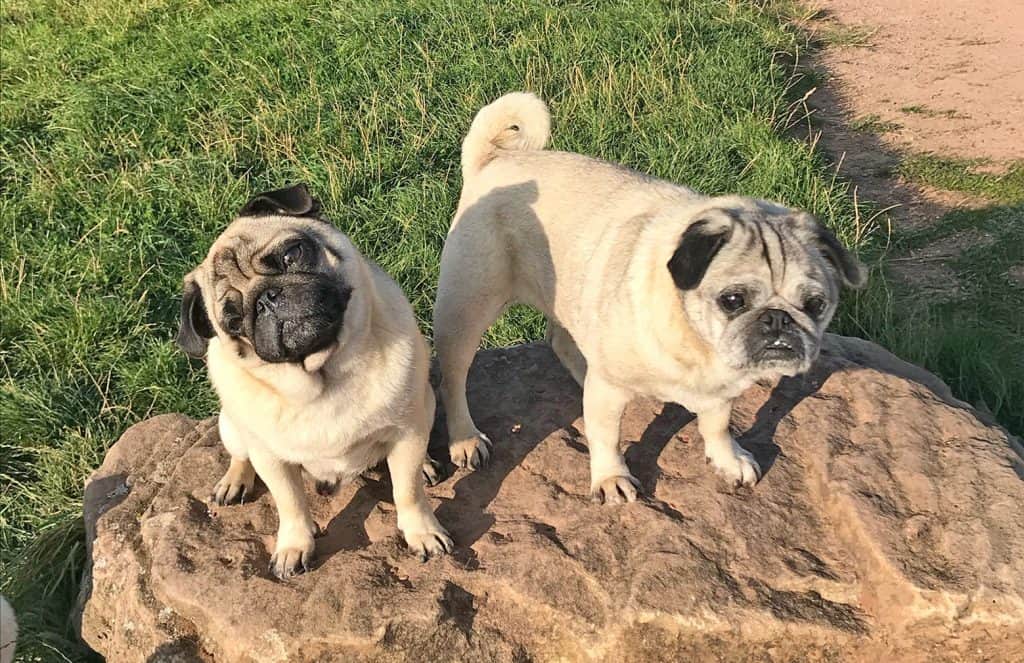
Percy & Alfie in the great outdoors













































